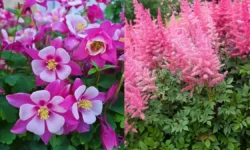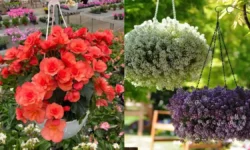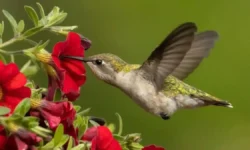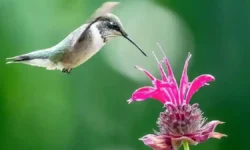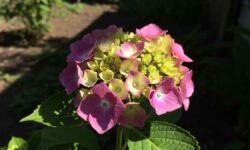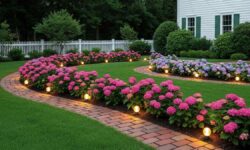If you’ve ever paused mid–coffee to watch a tiny blur of wings hover at a red bloom, you already know the joy of planting perennial flowers that attract hummingbirds. I’m a little obsessed—partly because the yard feels more alive, and partly because these birds are shameless show-offs. Below you’ll find my opinionated, practical guide to the best perennial flowers that attract hummingbirds, how to identify them fast, what they need (USDA zones, sun, soil, bloom time, color ranges), and how I group them so the nectar bar never closes.
Quick rule of thumb that’s never steered me wrong: tubular flowers, bold color (especially reds), and a season-long sequence of blooms. That combo keeps hummingbirds looping your garden like it’s their favorite cafe. (Yes, I schedule it like a menu.) Red, tubular blossoms and smart bloom succession are repeatedly recommended, along with matching plants to your USDA zone, so your choices actually thrive and feed birds all season.
Table of Contents
Best perennial flowers that attract hummingbirds (31 must-grow species)
Below are my favorite perennial flowers that attract hummingbirds. I’ve grouped each into quick ID + care notes so you can plant with confidence. Where it helps, I call out USDA Growing Zones, sun/soil needs, color varieties, bloom season, and the scientific name. Some entries include gentle style notes—what I actually pair them with in beds and borders.
A quick pointer before we dig in: tubular blooms and bold reds make a difference, plus choosing plants suited to your local climate. I also like to stagger bloom times so there’s always nectar on tap.
Bee Balm (Monarda)
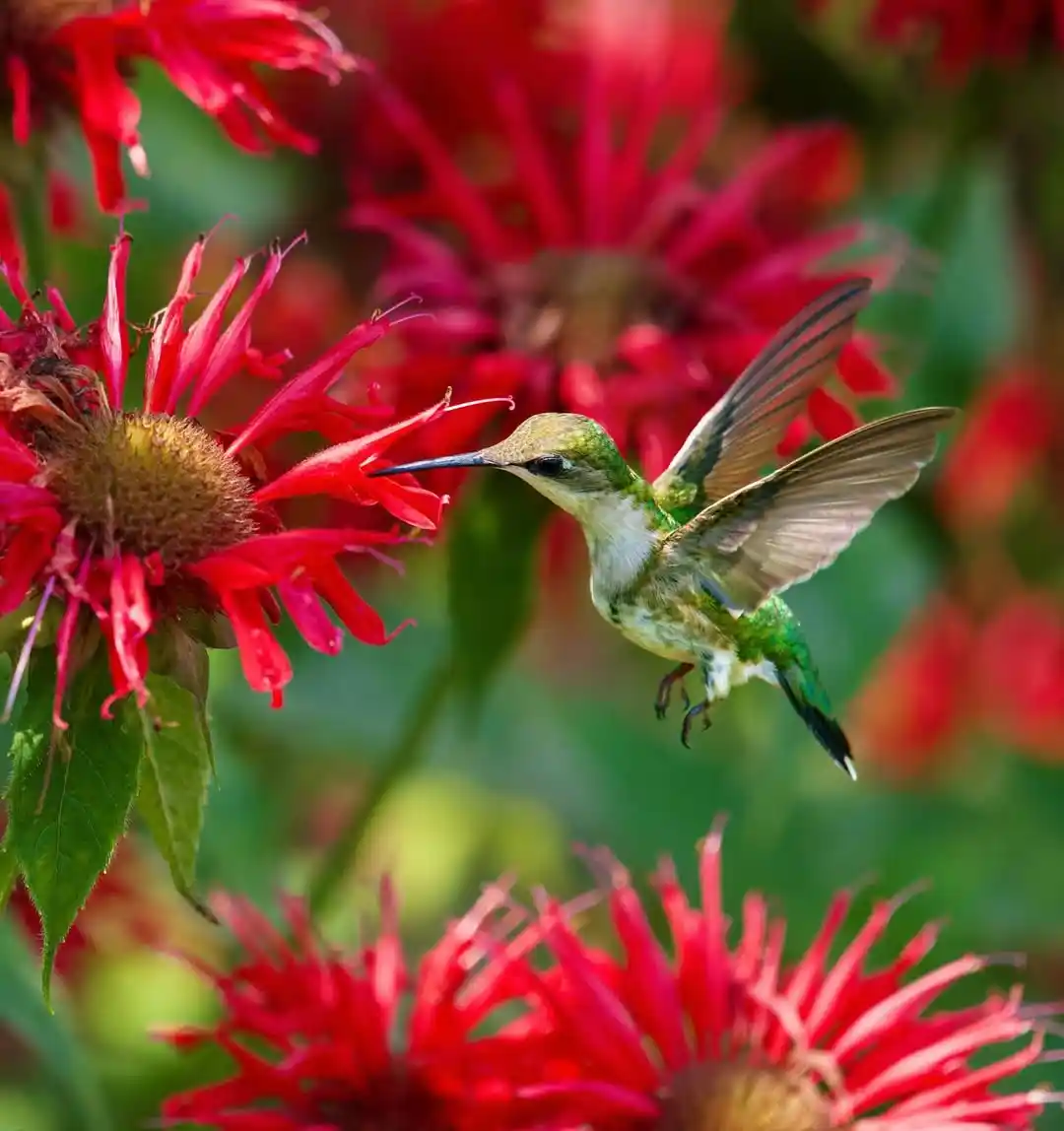
Identification & Character: Ragged, firework-like flower heads on square stems; aromatic leaves (yes, mint family vibes). Hummers zip to it like it’s VIP service.
USDA Zones: 3–9. Sun: Full sun (tolerates light shade). Soil: Rich, well-drained, consistently moist.
Bloom Season: Summer into fall. Color Varieties: Red, pink, purple, white. Type: Herbaceous perennial. Scientific Name: Monarda.
I deadhead for encore blooms and divide every few years to keep clumps vigorous (it wanders—welcome in cottage borders). Pick crimson or scarlet cultivars if you want instant “hummingbird magnet” energy. Bee balm is one of the most reliable perennial flowers that attract hummingbirds—a true staple plant.
Columbine (Aquilegia)
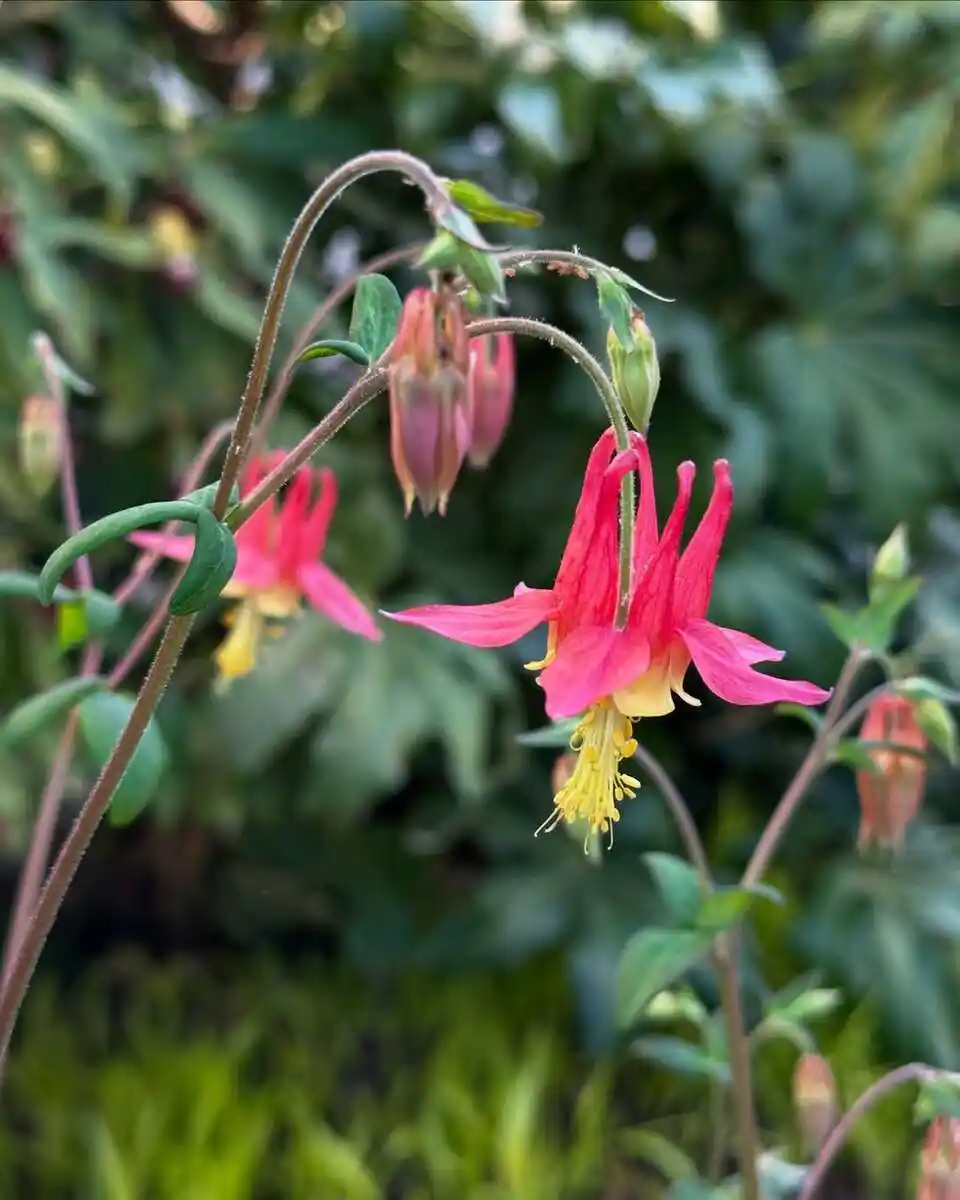
Identification & Character: Nodding, spurred blossoms—like tiny lanterns with tails. Red columbine is a hummer favorite.
USDA Zones: 3–8. Sun: Part shade to sun. Soil: Well-drained, average.
Bloom Season: Spring to early summer. Colors: Red, yellow, orange, pink, blue, purple, white. Type: Herbaceous perennial. Scientific: Aquilegia.
I tuck columbines along fence lines and under light, dappled shade where they self-seed into charming drifts. Their early bloom bridges the nectar gap after winter, which helps me keep hummingbird-friendly perennials flowering from spring through frost.
Salvia (Sage, multiple species)
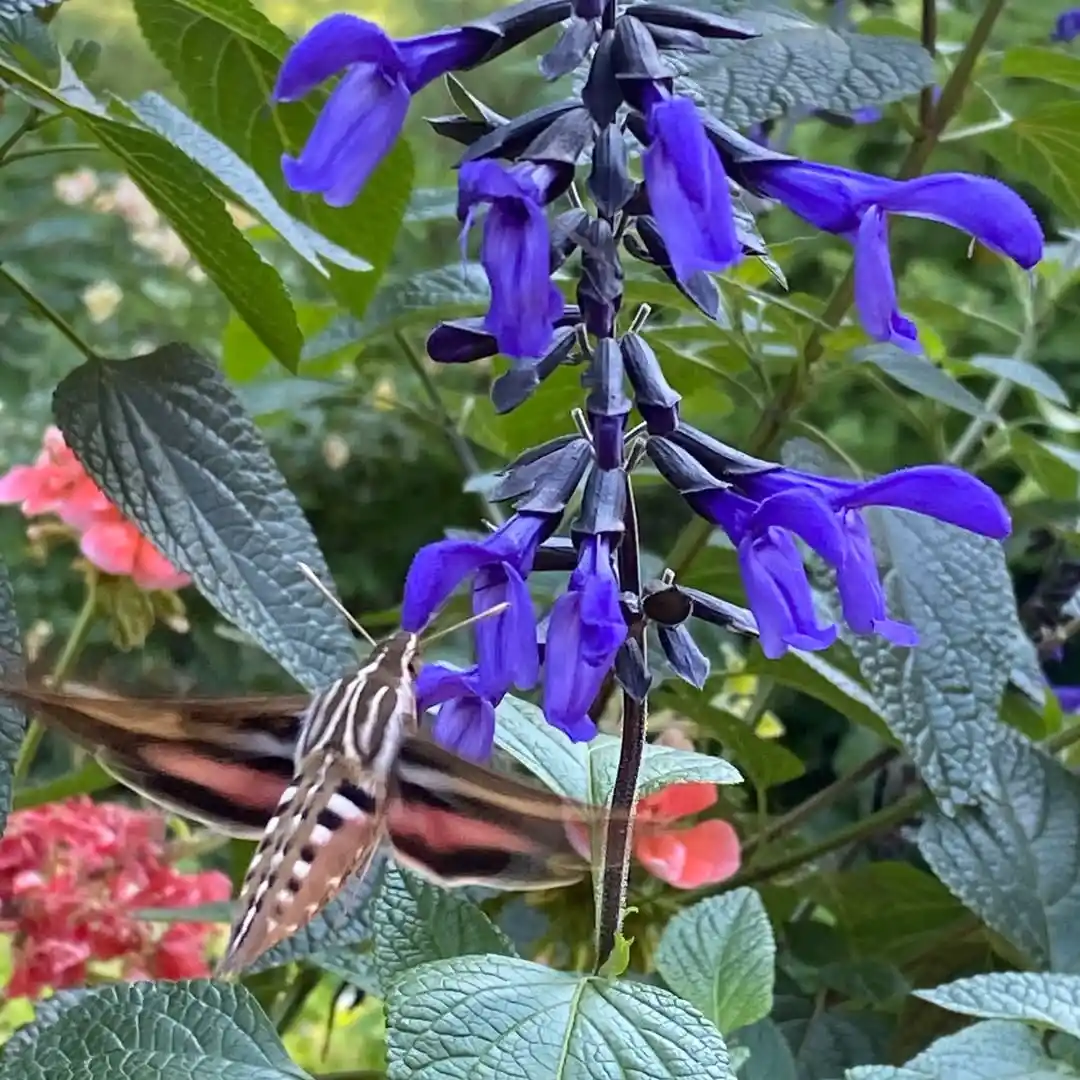
Identification & Character: Upright spires packed with tubular blooms; fragrant foliage; many species are drought-tough.
USDA Zones: Varies by species (many hardy in 5–9; some to 4 or to 10). Sun: Full. Soil: Well-drained, lean to average.
Bloom Season: Summer–fall (with strong repeat if deadheaded). Colors: Blue, purple, red, pink, white, even bicolors. Type: Perennial (some species annual). Scientific: Salvia spp.
Personal confession: I over-plant salvias because they’re low maintenance yet look deliberately designed. In the back third of a bed, they give height without fuss. Classic hummer picks include S. microphylla and S. greggii, which pair beautifully with soft grasses and pastel perennials. Salvias are dependable perennials for hummingbirds thanks to those nectar-rich tubes.
Hosta (Hosta spp.)
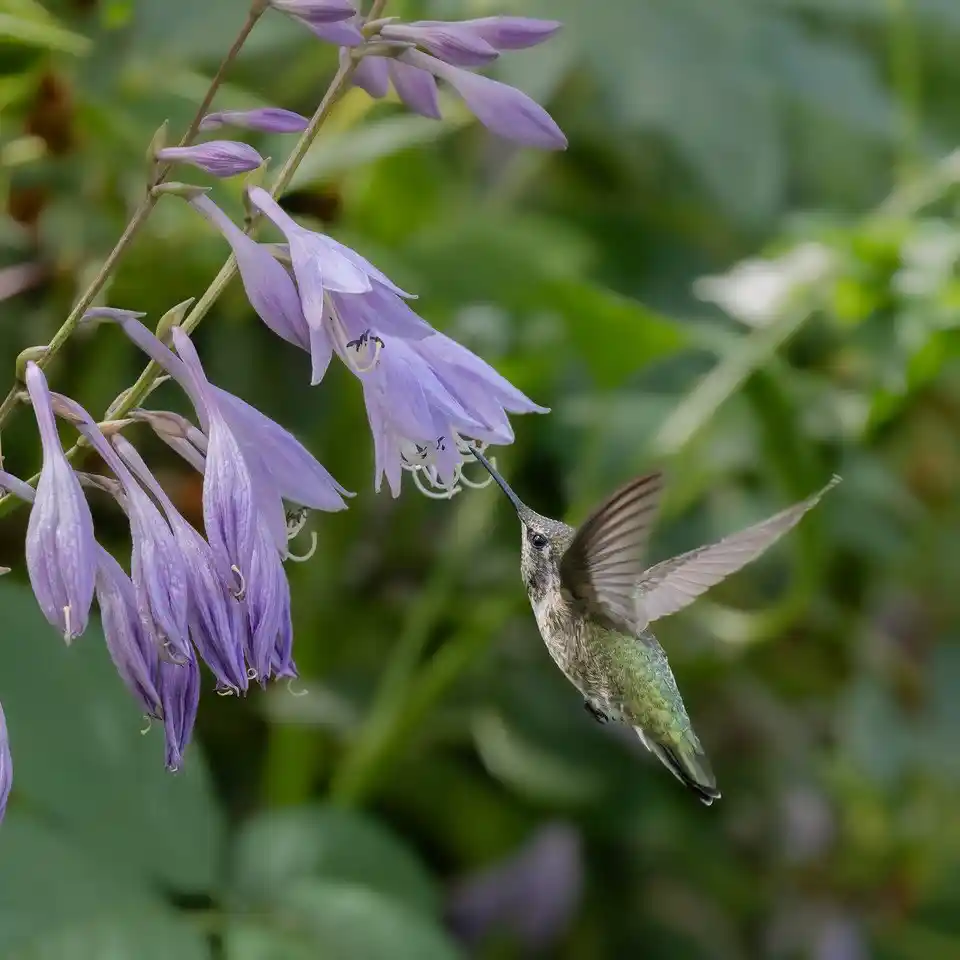
Identification & Character: Lush mounds of corrugated leaves; tall wands with tubular, often pale-lavender or white flowers—hummers work the blooms even in shade gardens.
USDA Zones: 3–9. Sun: Shade to part shade. Soil: Moist, rich, well-drained.
Bloom Season: Summer. Colors (flowers): White to lavender; foliage in blue-green/variegated tones. Type: Herbaceous perennial. Scientific: Hosta.
I love hostas precisely because they fill those moody, dappled corners where many nectar plants sulk. Keep the soil evenly moist and let the flower stalks stand for hummingbirds—don’t cut them prematurely. They’re excellent shade-tolerant hummingbird perennials.
Coral Bells (Heuchera)
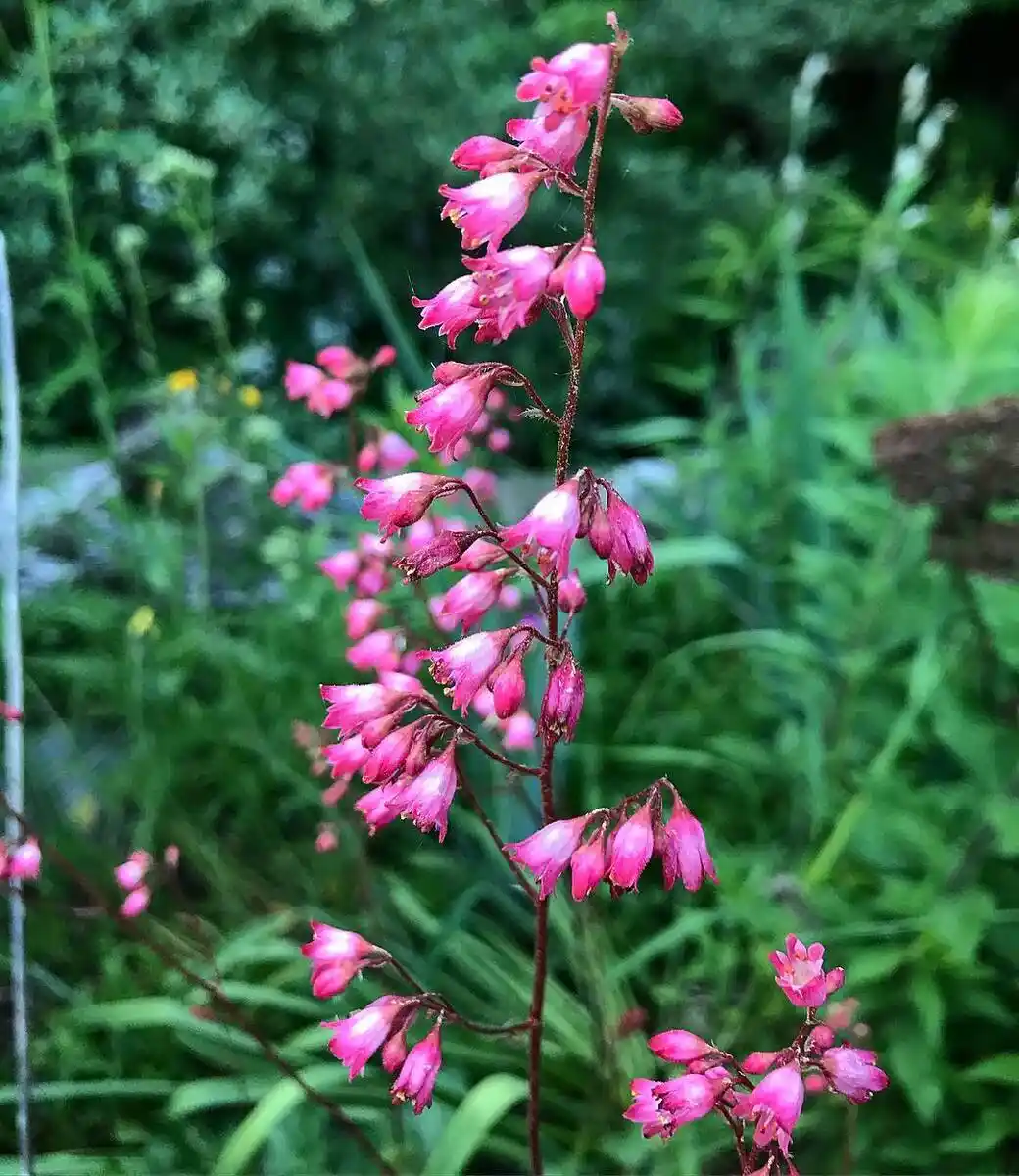
Identification & Character: Compact mounds of jewel-tone foliage (caramel, lime, merlot, silver) topped with airy wands of bell-shaped blooms.
USDA Zones: 3–10. Sun: Part shade (avoid scorching sites). Soil: Well-drained, humus-rich.
Bloom Season: Late spring to midsummer. Colors: Many foliage hues; flowers in pinks/whites/reds. Type: Herbaceous perennial. Scientific: Heuchera.
Heuchera is my “threading” plant—I use it to link bold flowers with calm foliage, and the blooms bring in hummingbirds without shouting. Ideal under open canopies and in north-facing borders where you want color that lasts.
Lupine (Lupinus)
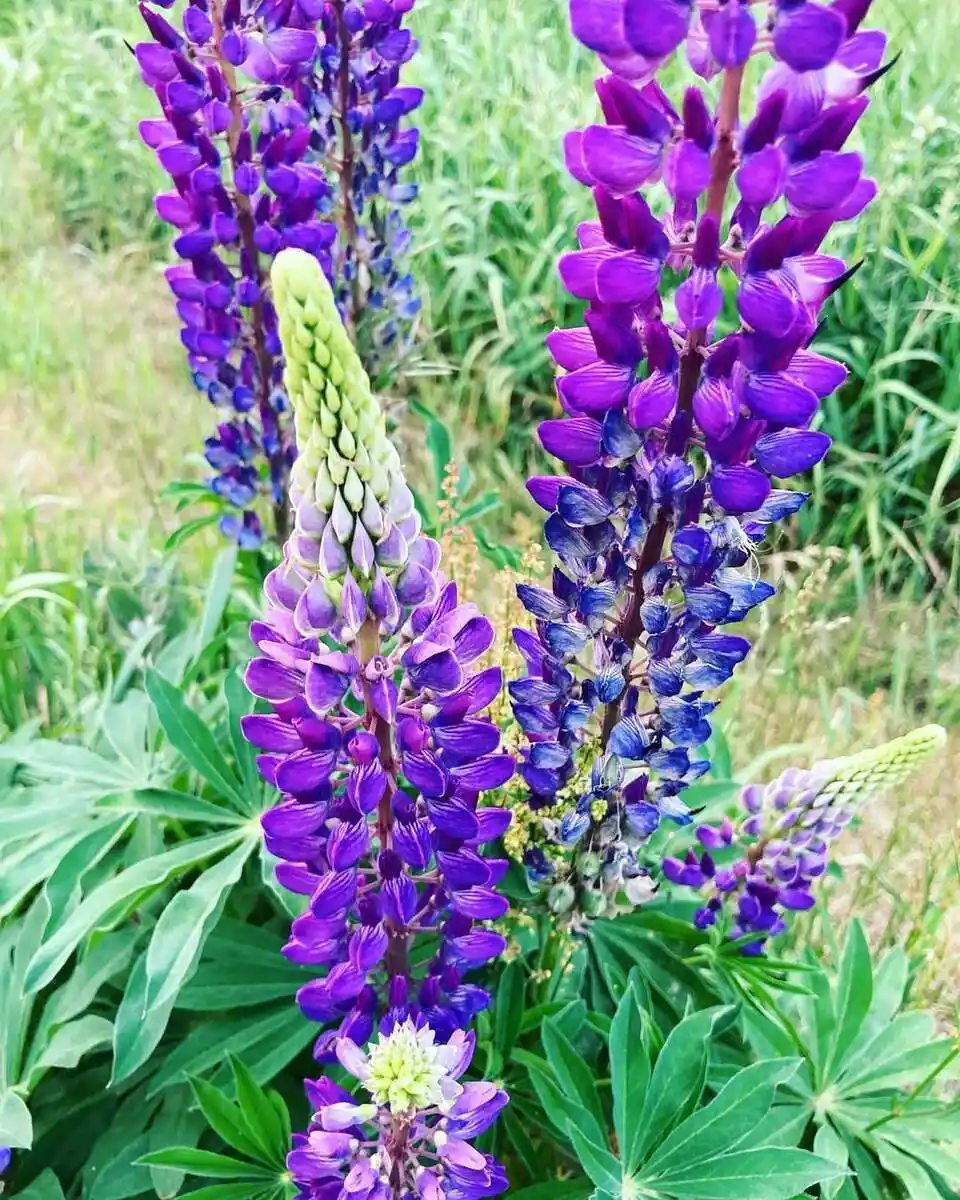
Identification & Character: Tall candles of pea-like flowers above palmate leaves; a snapshot-worthy cottage-garden signature.
USDA Zones: 4–8. Sun: Full sun. Soil: Well-drained, slightly acidic preferred.
Bloom Season: Late spring to early summer. Colors: Red, pink, yellow, blue, purple, white; many bicolors. Type: Herbaceous perennial/short-lived perennial. Scientific: Lupinus.
Stake taller spikes in windy sites, or try compact varieties along paths. Lupines can be short-lived but they are glorious when they hit; I replace clumps every few years and let a few go to seed to keep them cycling through.
Penstemon (Beardtongue)
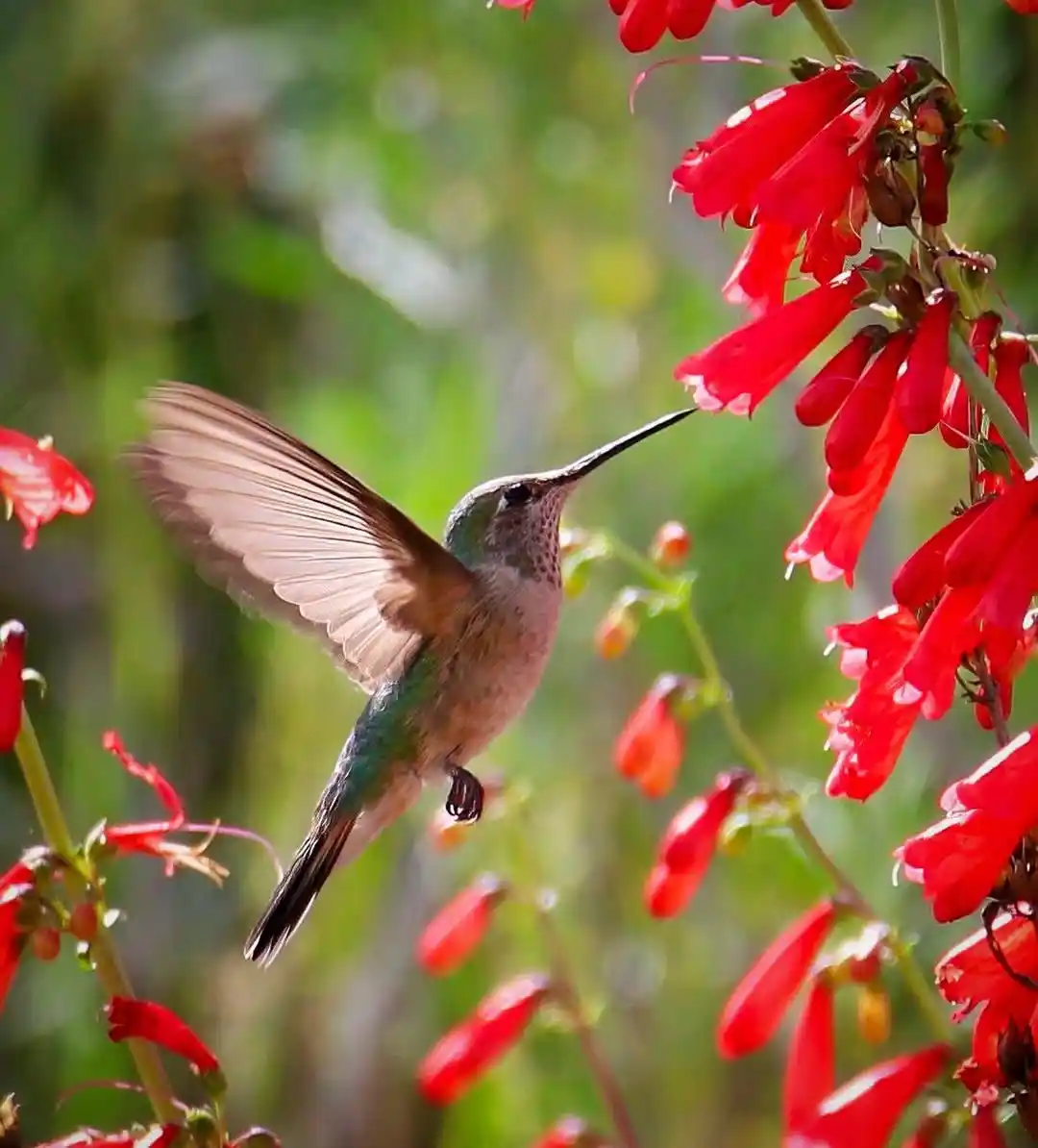
Identification & Character: Sleek, tubular bells lined up on slender wands—a perfect fit for hummingbird bills.
USDA Zones: 4–9 (varies). Sun: Full. Soil: Sharp drainage, even gravelly.
Bloom Season: Early to mid-summer (some repeat). Colors: Red, pink, purple, blue, white. Type: Herbaceous perennial. Scientific: Penstemon.
This is my “dry garden” workhorse among perennial flowers that attract hummingbirds. In lean soils and full sun, it stays upright and floriferous. I shear lightly after a flush to nudge a second wave.
Daylily (Hemerocallis)
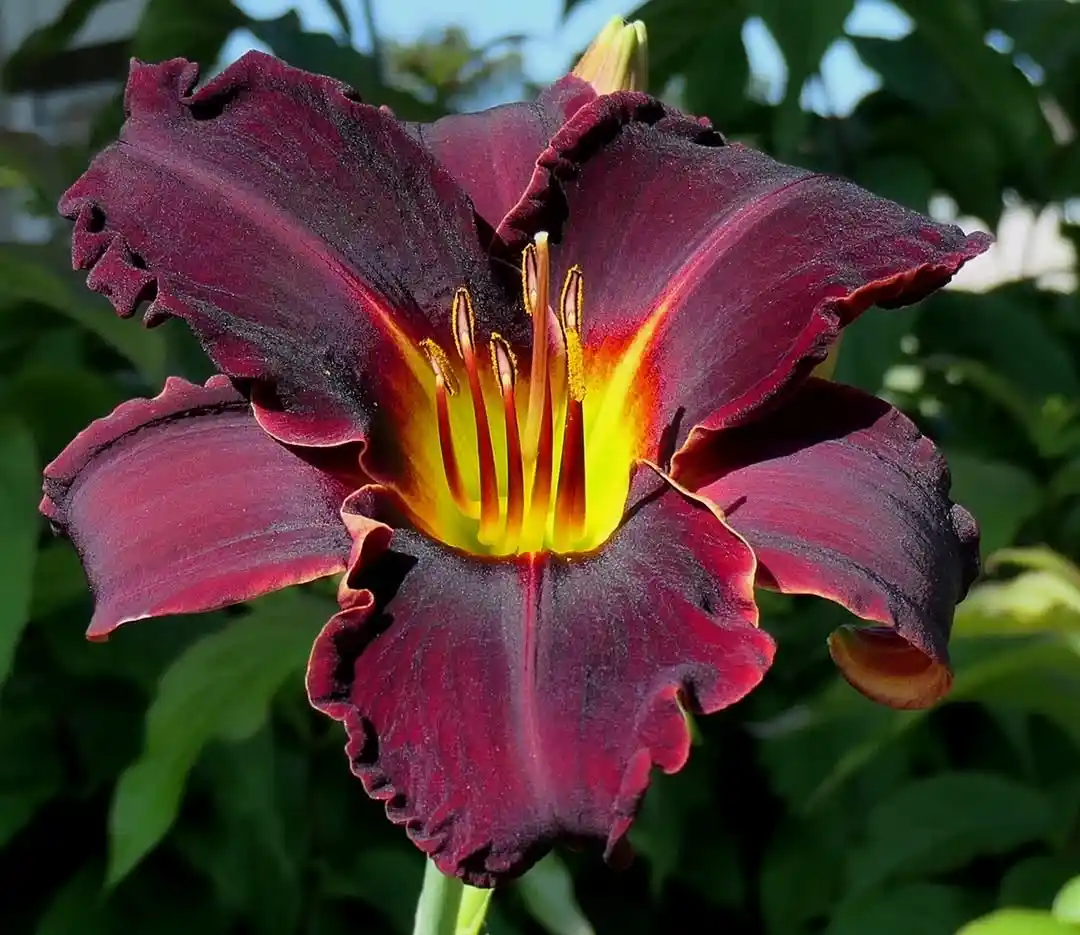
Identification & Character: Arching fans of strappy foliage; dozens of trumpet flowers per scape over weeks (each individual bloom lasts one day—don’t panic).
USDA Zones: 3–10. Sun: Full sun for best bloom. Soil: Adaptable, well-drained.
Bloom Season: Spring through late summer (by cultivar). Colors: Near-white to lemon, apricot, orange, red, burgundy, purples, blends. Type: Herbaceous perennial. Scientific: Hemerocallis.
I treat daylilies like paint—curate a gradient (fiery reds near cooler purples) to guide the eye. Hummers adore the flared throats. Deadhead spent blooms and divide clumps every few years to keep the show rolling.
Agastache (Hummingbird Mint)
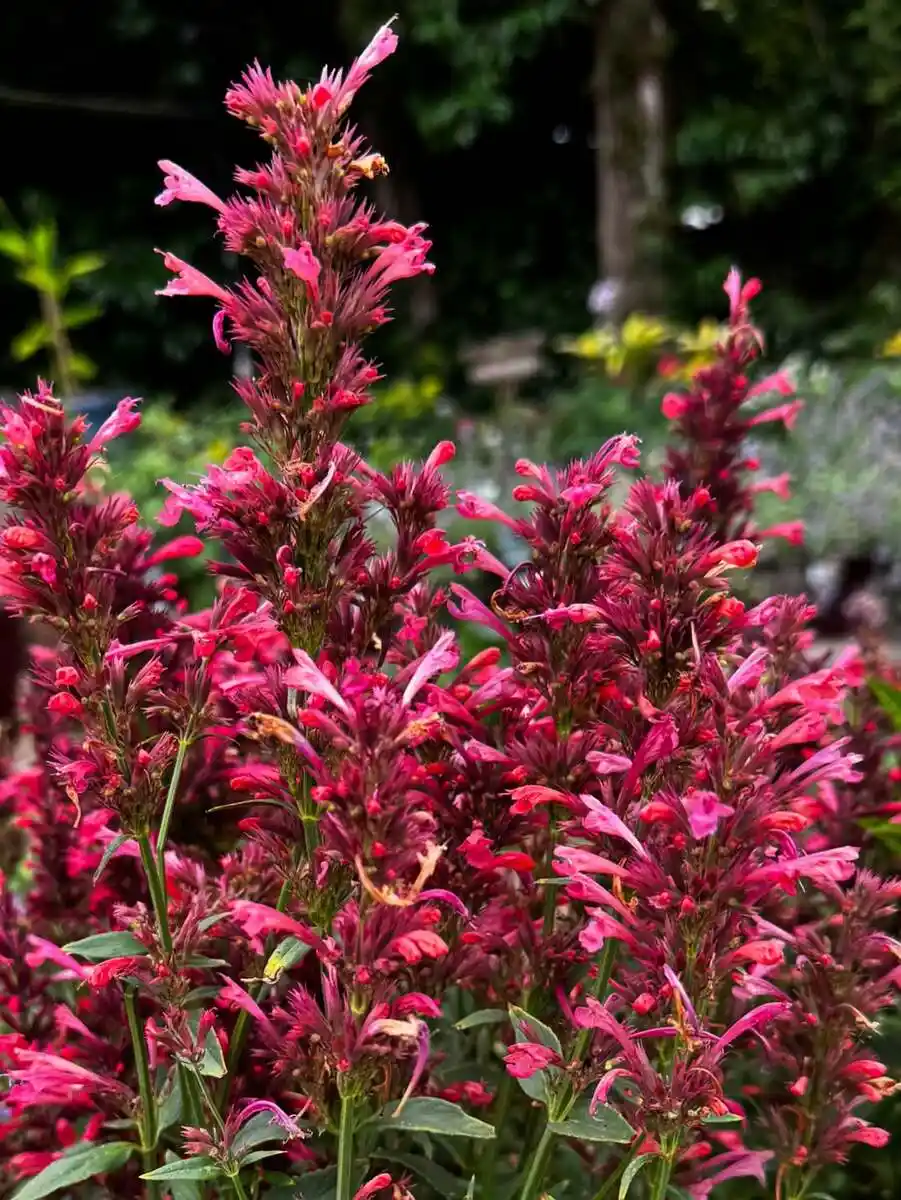
Identification & Character: Aromatic spikes packed with nectar; upright habit that plays nicely with grasses.
USDA Zones: Commonly 5–9 (varies by species). Sun: Full. Soil: Well-drained, even dry.
Bloom Season: Midsummer to fall. Colors: Coral, pink, salmon, purple, orange. Type: Herbaceous perennial. Scientific: Agastache spp.
Where summers are hot and dry, Agastache is gold—drought-lean and hummingbird-rich. Cluster three to five plants for a serious nectar station and add a flat stone nearby for bird perches between sips. (Yes, I actually place rocks for them.)
Foxglove (Digitalis)
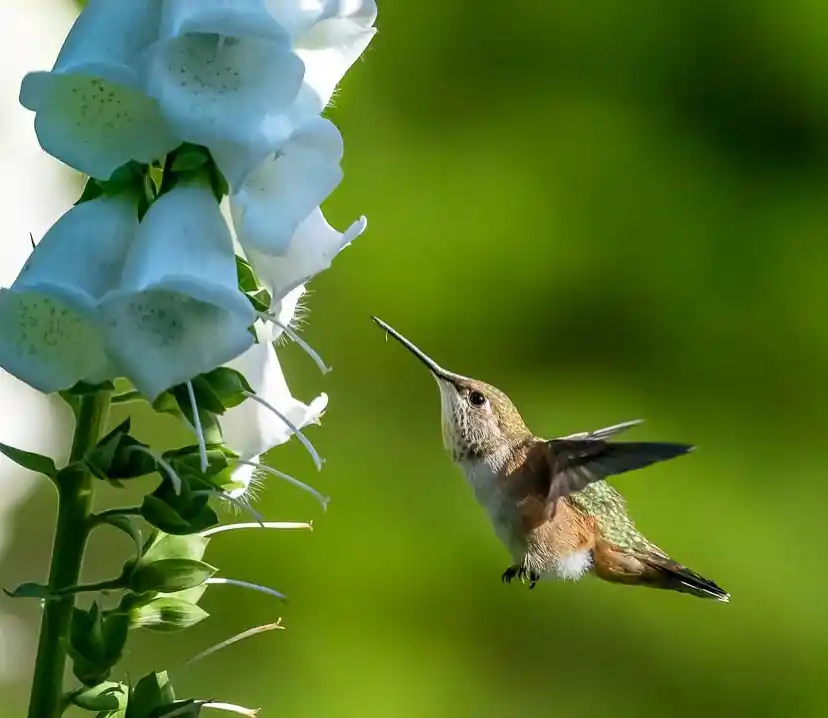
Identification & Character: Statuesque spires dotted with speckled throats; classic cottage drama.
USDA Zones: Generally 4–9 (species vary; some are biennial/short-lived). Sun: Part shade to sun. Soil: Moist, well-drained.
Bloom Season: Late spring to early summer. Colors: White, cream, pink, apricot, rose, purple. Type: Short-lived perennial/biennial. Scientific: Digitalis.
I underplant foxgloves with low mounds (heuchera, catmint) so the spires look intentional, not lonely. Safety note: foxglove is poisonous if ingested—plant thoughtfully if pets or small kids roam.
Cardinal Flower (Lobelia cardinalis)
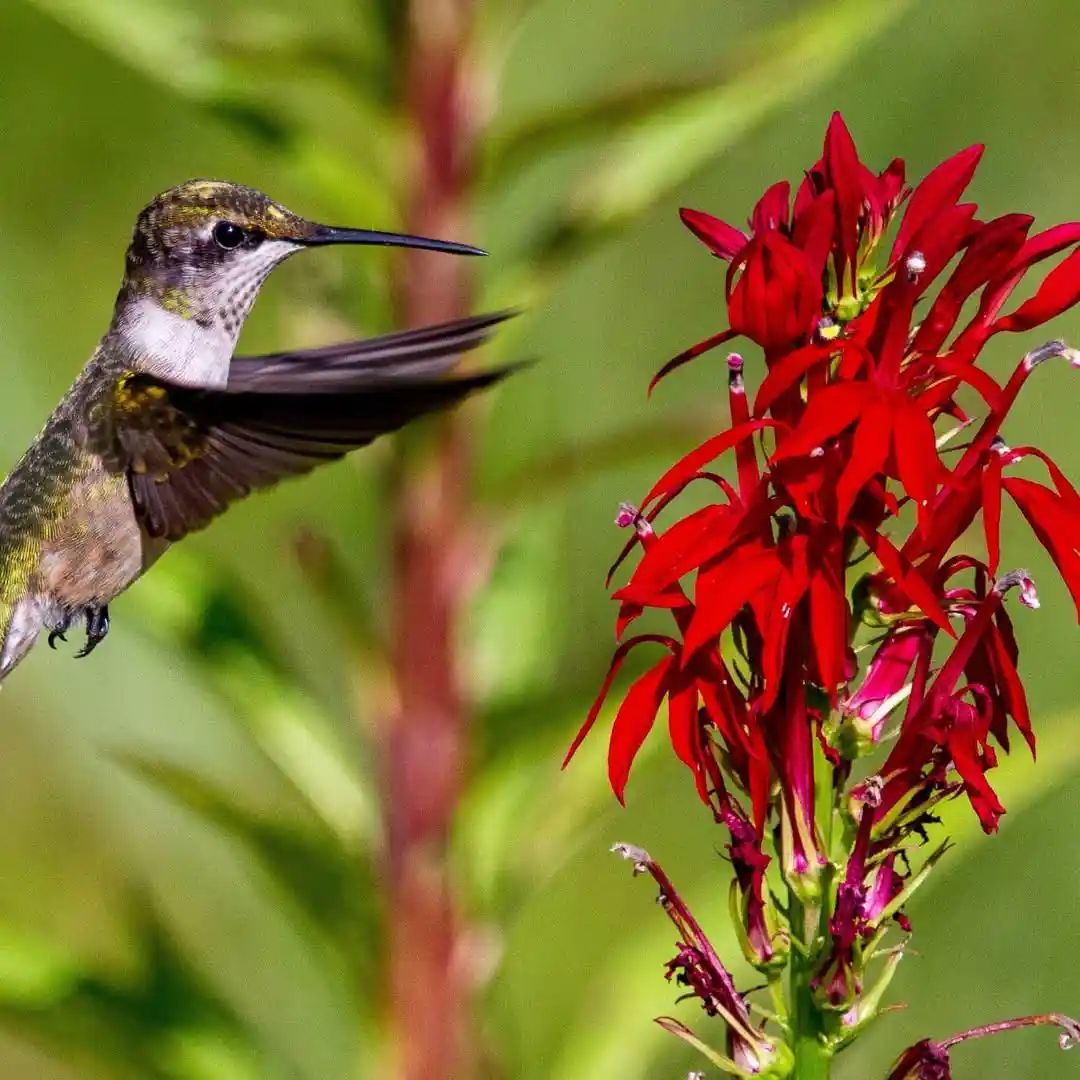
Identification & Character: Intensely red, vertical spikes—arguably the most electrifying red in the border. Tubular blooms are classic hummer fuel.
USDA Zones: 3–9. Sun: Partial sun to full sun with moisture. Soil: Rich, consistently moist; loves pond edges and rain gardens.
Bloom Season: Summer to early fall. Colors: Mainly scarlet red (select forms in pink/white). Type: Herbaceous perennial (short-lived but self-seeds). Scientific: Lobelia cardinalis.
I mass three or more behind lower perennials so the tall wands read as a dramatic backdrop. It relies heavily on hummingbirds for pollination and absolutely thrives with steady moisture—keep it watered and it will pay you back with nonstop visits.
Butterfly Weed (Asclepias tuberosa)
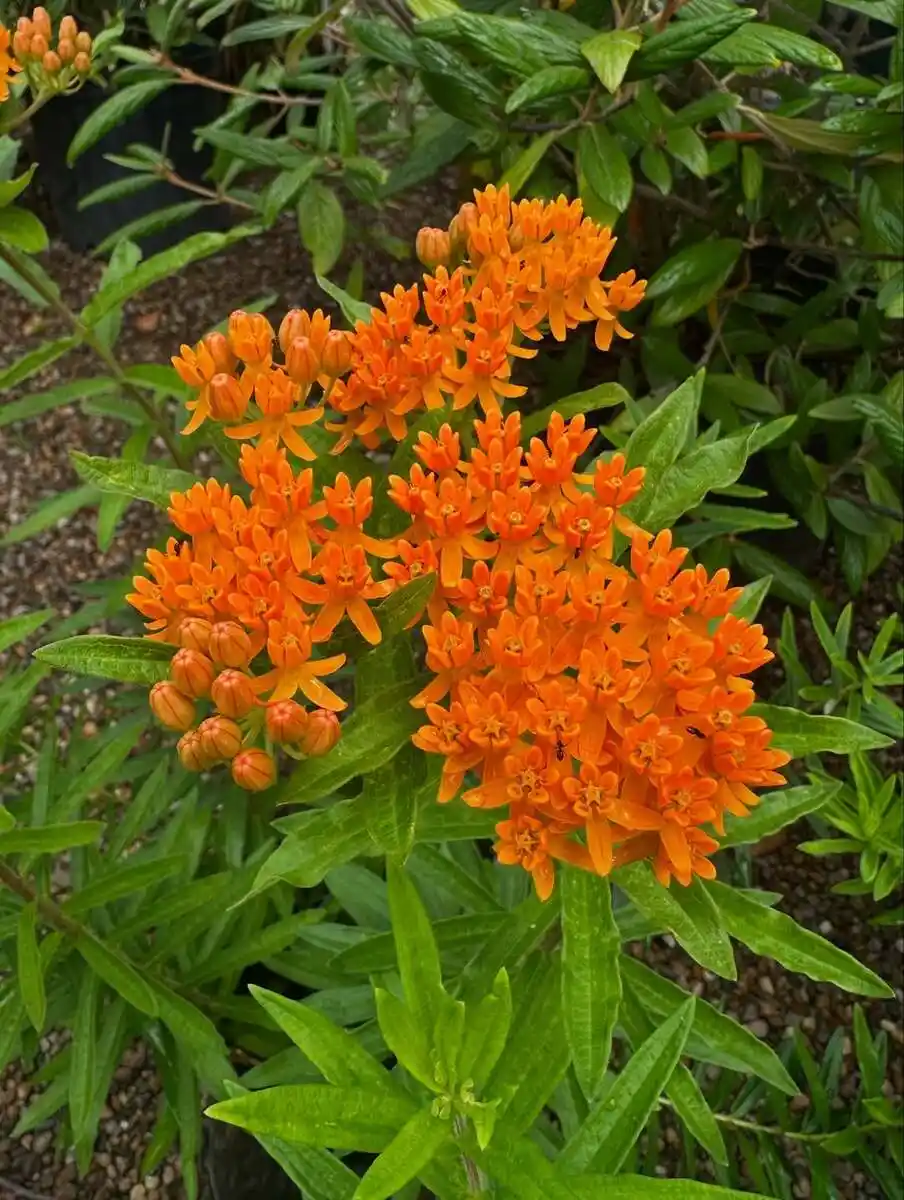
Identification & Character: Flat-topped clusters of blazing orange; narrow leaves; monarch host plus hummingbird pit-stop.
USDA Zones: 3–9. Sun: Full. Soil: Dry to average, well-drained.
Bloom Season: Early to midsummer (with seedpods later). Colors: Orange (mostly), some yellow. Type: Herbaceous perennial. Scientific: Asclepias tuberosa.
I treat butterfly weed as the hot-border anchor, pairing it with purple salvia and red daylilies. Provide full sun and resist coddling—less water keeps it upright and floriferous.
Trumpet Vine / Trumpet Creeper (Campsis radicans)
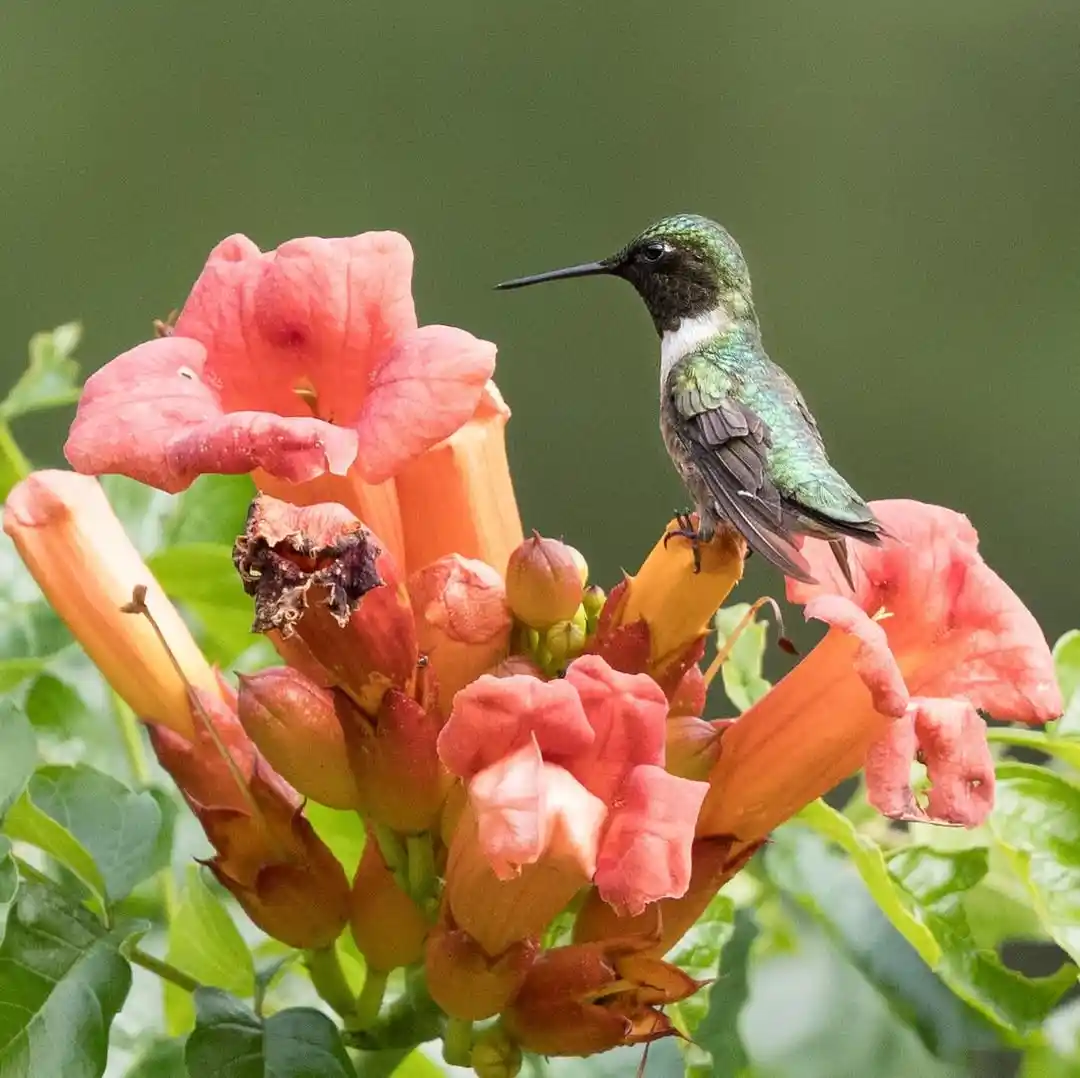
Identification & Character: Vigorous climber with large, flared, trumpet-shaped flowers—literal hummingbird runway lights.
USDA Zones: 4–9. Sun: Sun to part sun. Soil: Average, well-drained; not picky.
Bloom Season: Summer into fall. Colors: Orange, red, yellow. Type: Woody perennial vine. Scientific: Campsis radicans.
A little personal honesty: this vine can overdo it. I grow it on a sturdy arbor and prune hard after bloom to control its enthusiasm. Among perennial flowers that attract hummingbirds, trumpet vine is wildly effective—just give it a job and boundaries.
Bleeding Heart (Dicentra)
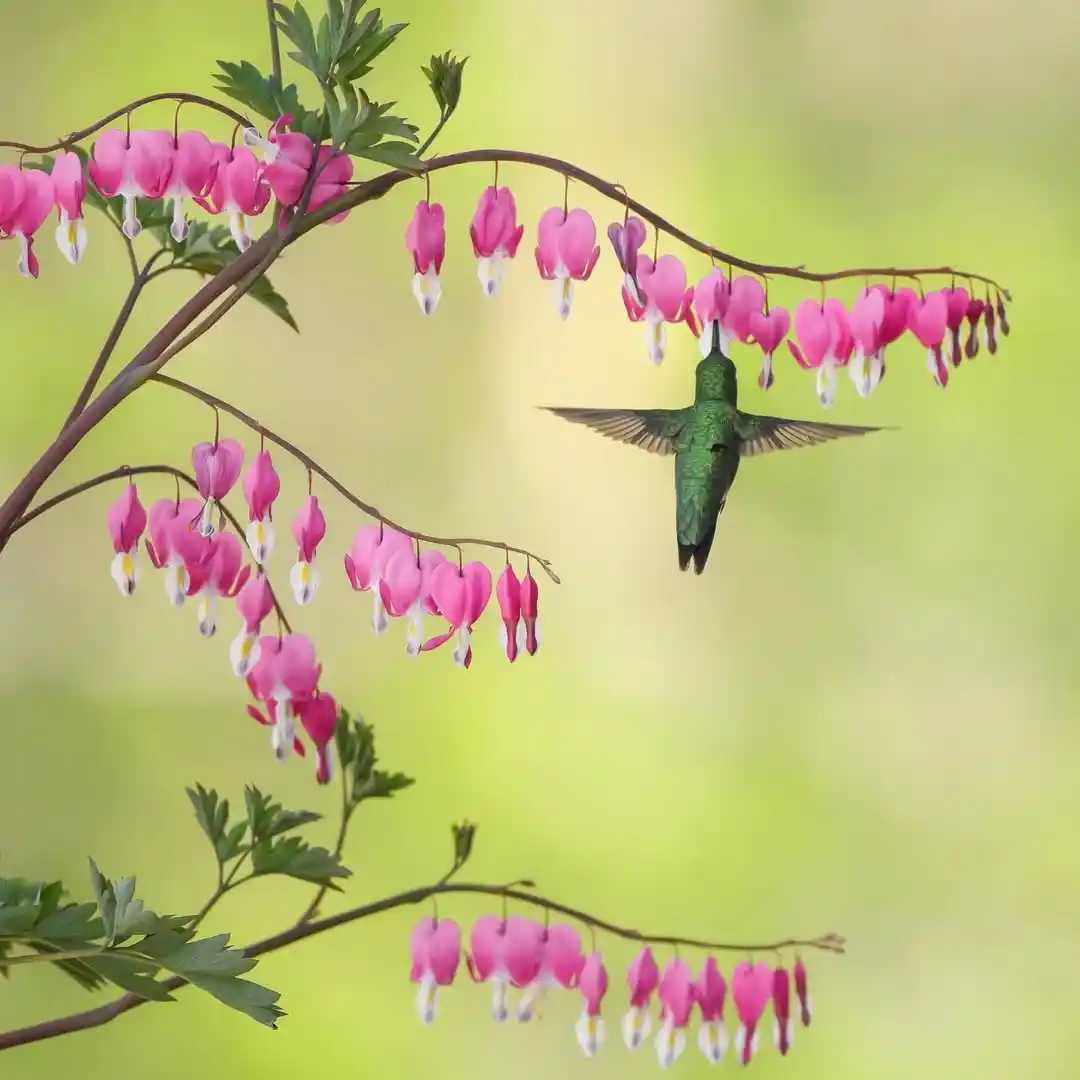
Identification & Character: Arching stems of heart-shaped charms; the shade garden heart-throb.
USDA Zones: 2–9. Sun: Shade to part shade. Soil: Moist, well-drained.
Bloom Season: Spring. Colors: Pink, white, red tones (by species/cultivar). Type: Herbaceous perennial (summer dormancy in heat). Scientific: Dicentra.
I plant bleeding heart near hostas and ferns to mask foliage when it goes summer-dormant. The early nectar helps kick-start spring hummingbird visits.
Red Hot Poker (Kniphofia)
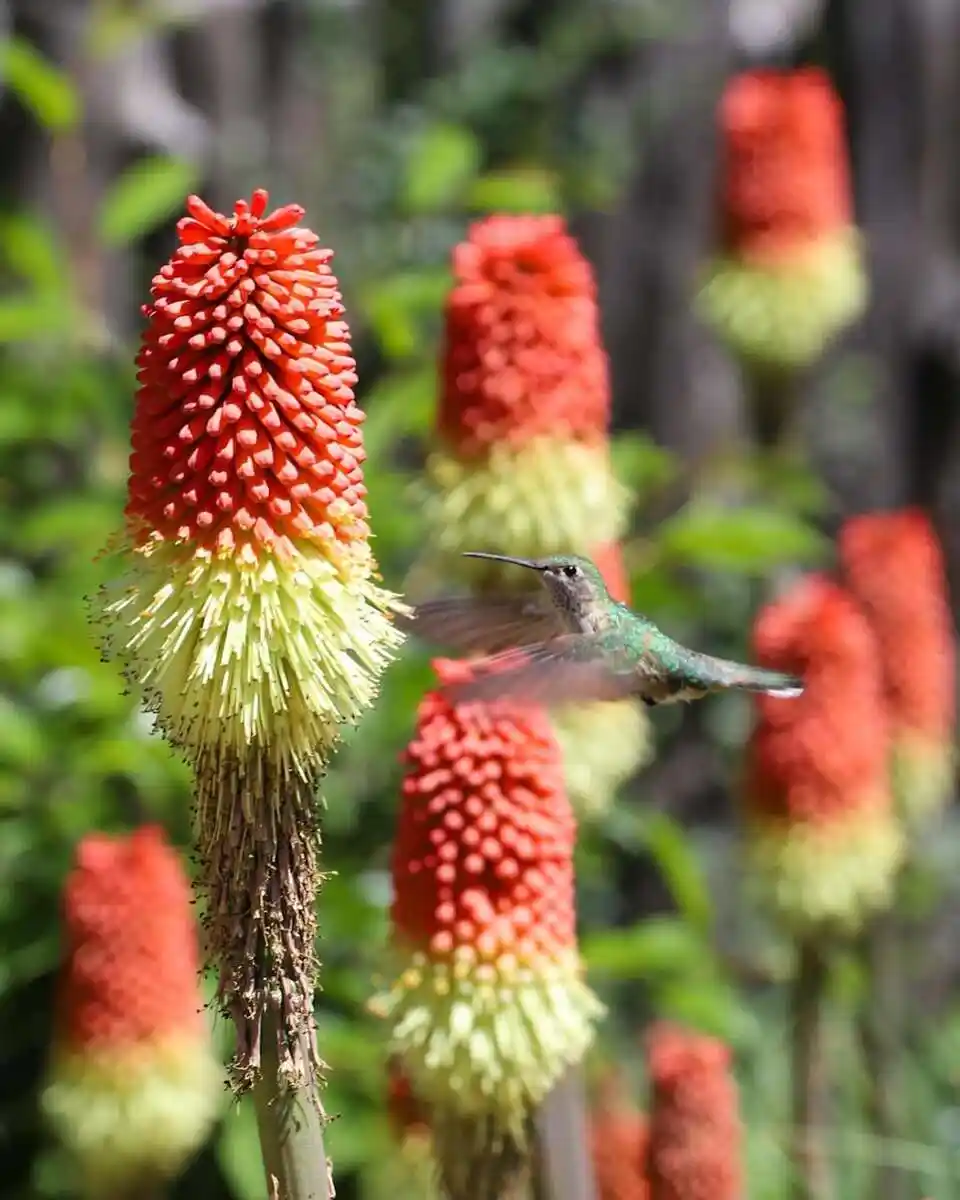
Identification & Character: Torch-like spikes that color-shift as they open—think mango sorbet to papaya red.
USDA Zones: Commonly 5–9 (check cultivar). Sun: Full. Soil: Free-draining (winter-wet kills it).
Bloom Season: Early summer through summer (by type). Colors: Yellow, orange, red bicolors. Type: Herbaceous perennial. Scientific: Kniphofia.
I set pokers as exclamation points among grasses and purple perennials; the color contrast reads modern without trying. Great for hot, sunny slopes that need drama and nectar.
Honeysuckle (Lonicera spp., including Trumpet Honeysuckle L. sempervirens)
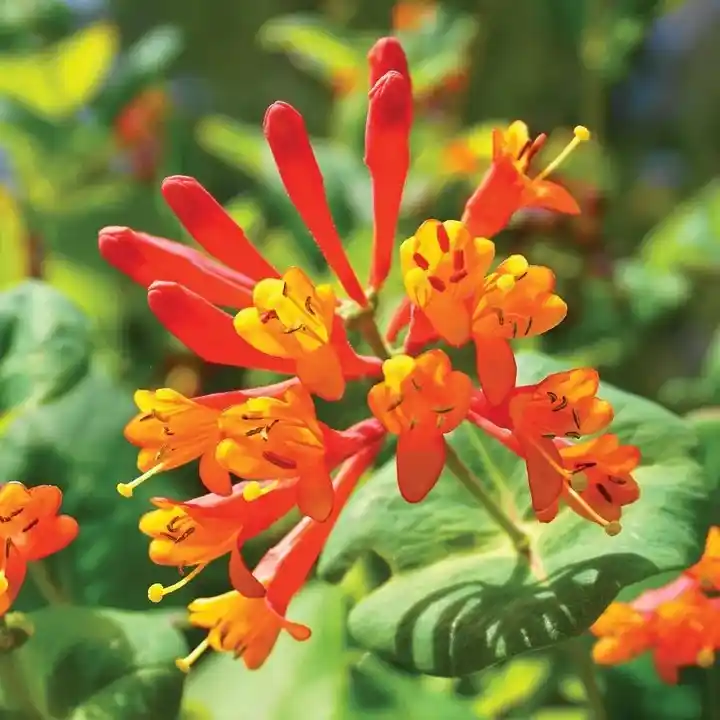
Identification & Character: Twining vine or shrub with sweetly scented, tubular flowers (classic hummingbird shape).
USDA Zones: Varies by species; L. sempervirens often 4–9. Sun: Sun to part sun. Soil: Average.
Bloom Season: Spring to summer; some repeat. Colors: Coral-red, orange, yellow, creamy white. Type: Woody perennial. Scientific: Lonicera spp.
I prefer the native trumpet honeysuckle for hummingbirds—less invasive than Japanese honeysuckle and generous with blooms on a trellis. It’s a solid backbone for a vertical nectar layer.
Fuchsia (Fuchsia spp.)
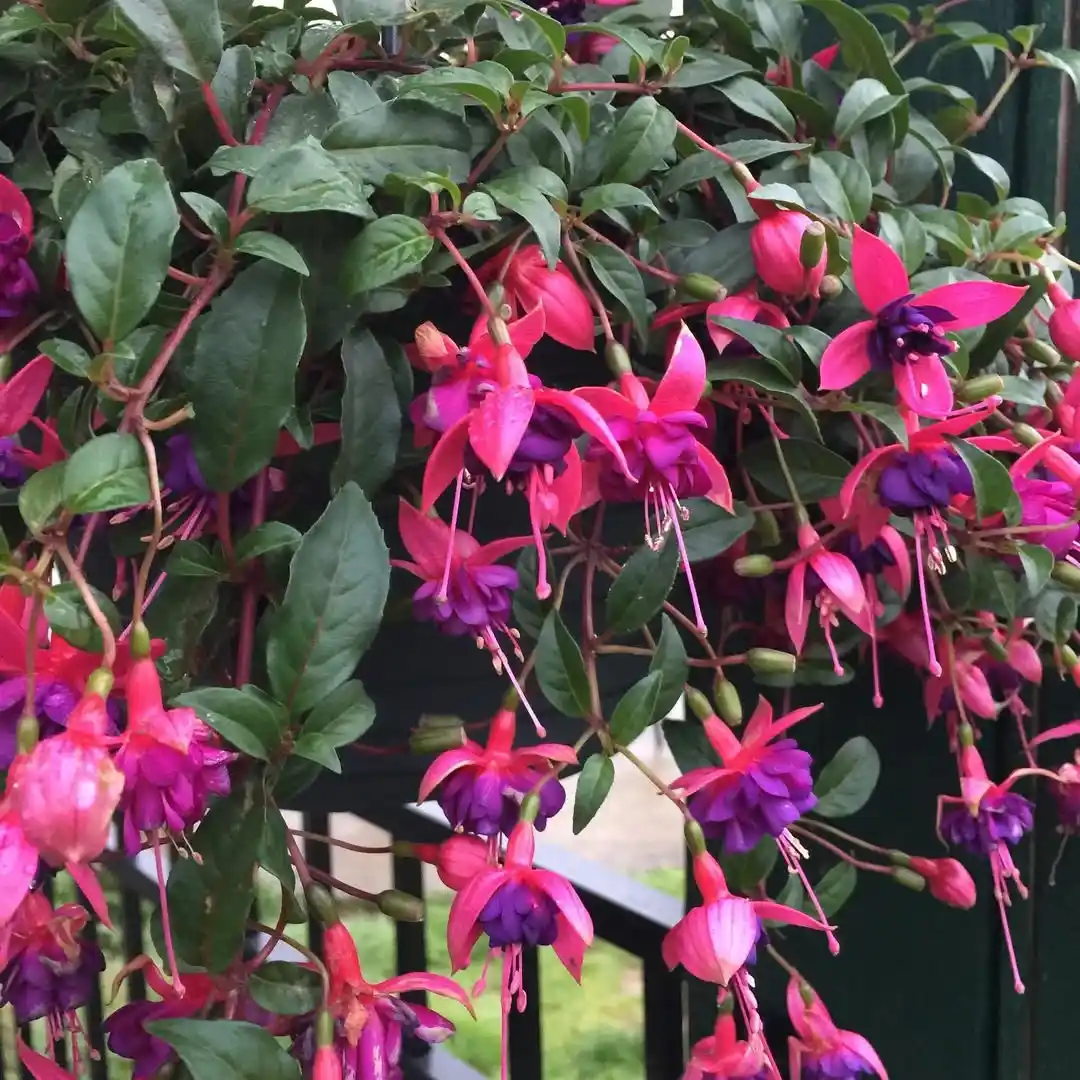
Identification & Character: Pendant, ballerina-skirt blossoms perfect for containers by a backdoor where you actually see the birds feed.
USDA Zones: Tender perennial in many climates (hardy species exist). Sun: Bright shade/filtered light. Soil: Rich and well-drained with consistent moisture.
Bloom Season: Long—late spring to fall in cool summer climates. Colors: Raspberry, magenta, purple, white combinations. Type: Perennial/subshrub (varies). Scientific: Fuchsia.
I hang fuchsias at shoulder height—you’ll be stunned how close hummingbirds feed when you’re quietly sipping tea two feet away.
Delphinium (Delphinium spp.)
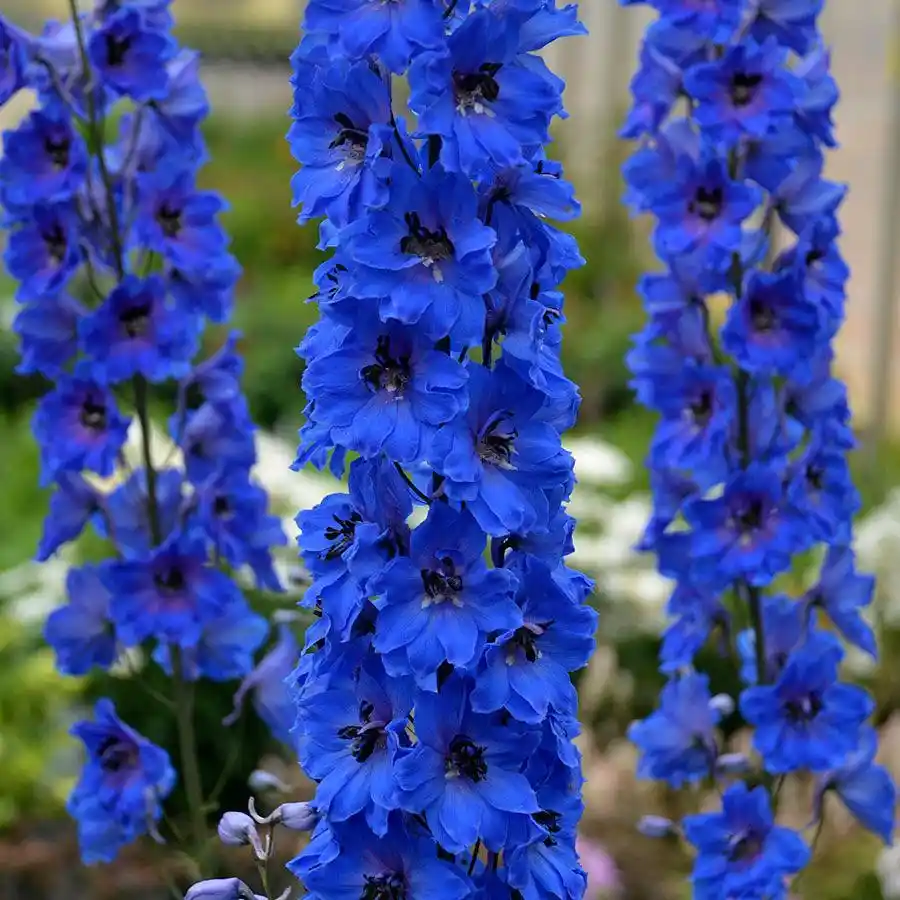
Identification & Character: Noble spires of densely packed florets—blue notes few perennials can match.
USDA Zones: Often 3–7 (heat sensitive). Sun: Full sun where summers are mild; part sun where hot. Soil: Rich, well-drained, evenly moist.
Bloom Season: Early to midsummer (with possible later flush). Colors: Signature blues plus white, pinks, purples. Type: Herbaceous perennial. Scientific: Delphinium.
Stake early (trust me) and feed lightly; delphiniums are a diva worth pampering—hummingbirds agree. I set them mid-border with a low hedge of nepeta for a tidy base.
Jacob’s Ladder (Polemonium caeruleum)
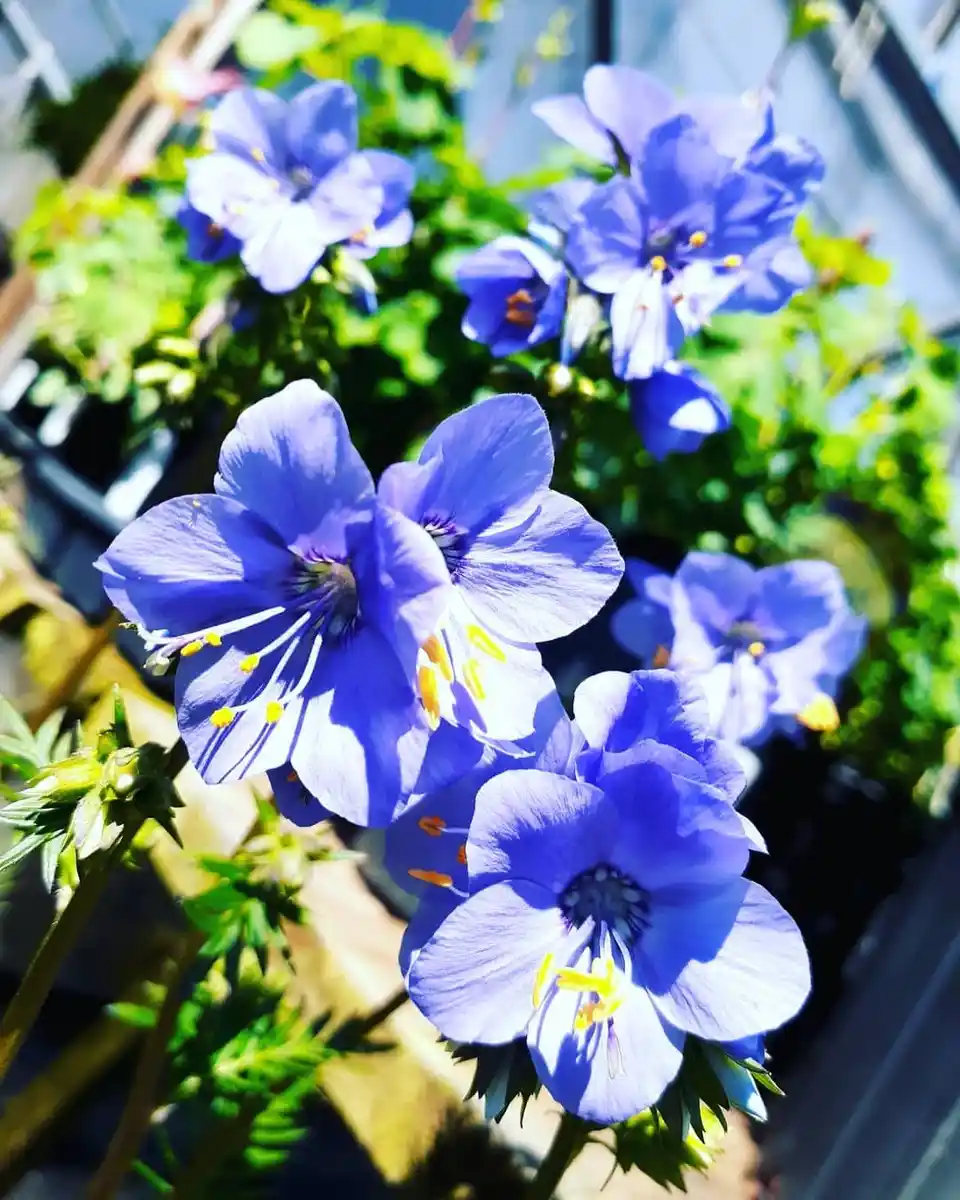
Identification & Character: Ferny, ladder-rung foliage under clusters of porcelain-blue bells.
USDA Zones: Typically 3–7. Sun: Part shade (cool summers allow more sun). Soil: Moist, well-drained, humus-rich.
Bloom Season: Late spring to early summer. Colors: Blue, white selections. Type: Herbaceous perennial. Scientific: Polemonium caeruleum.
I use it to cool down hot color schemes—blue settles everything. The tidy habit and early bloom make it perfect in front of taller nectar plants.
Wild Bergamot (Monarda fistulosa)
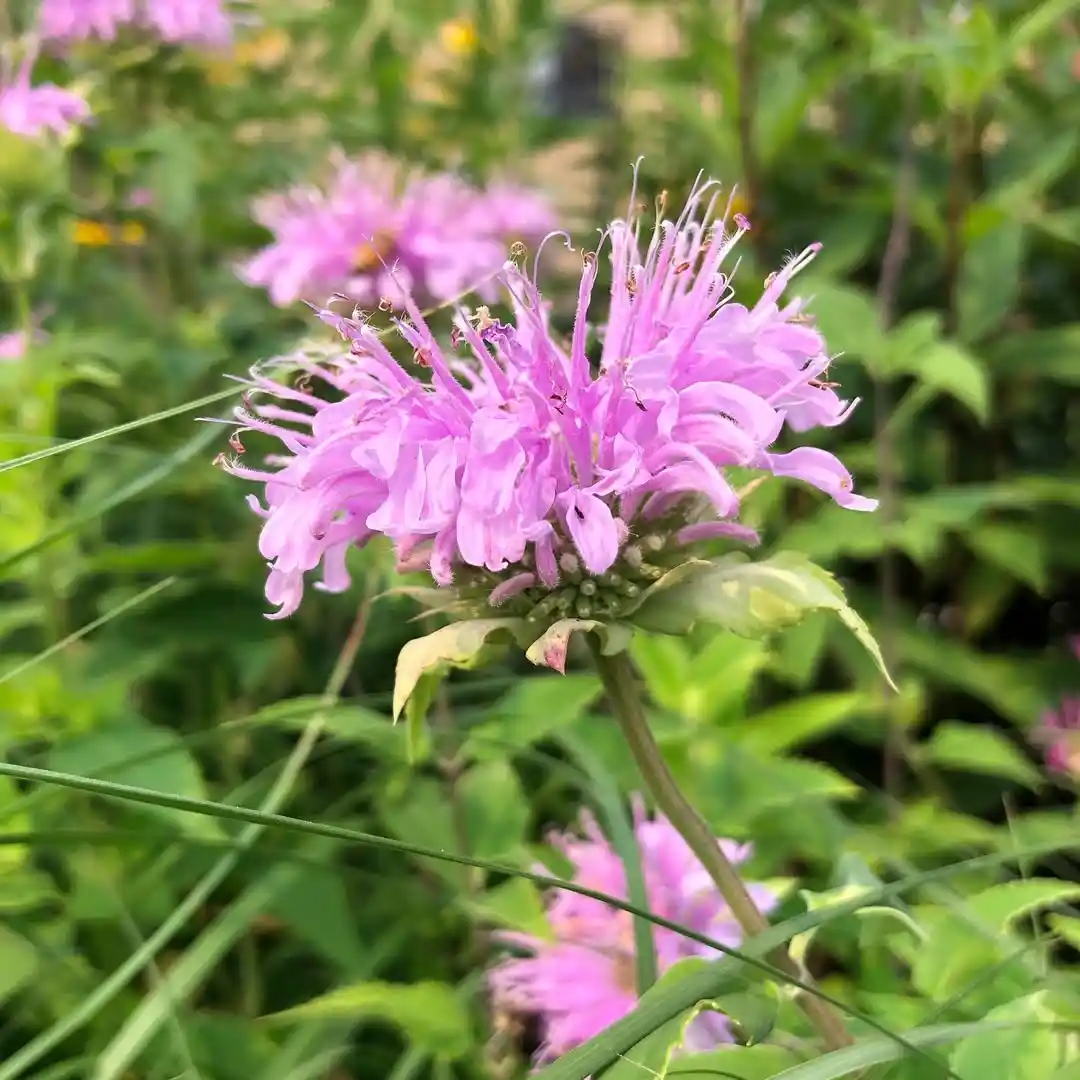
Identification & Character: Lavender-purple bee balm cousin with that same shaggy crown—and the same hummer appeal.
USDA Zones: 3–9 (varies regionally). Sun: Full. Soil: Average, well-drained.
Bloom Season: Summer. Colors: Lavender to lilac. Type: Herbaceous perennial. Scientific: Monarda fistulosa.
Use M. fistulosa where you want softer, meadowy color versus the stop-sign red of classic bee balm. Both are hall-of-fame hummingbird perennials.
Obedient Plant (Physostegia virginiana)
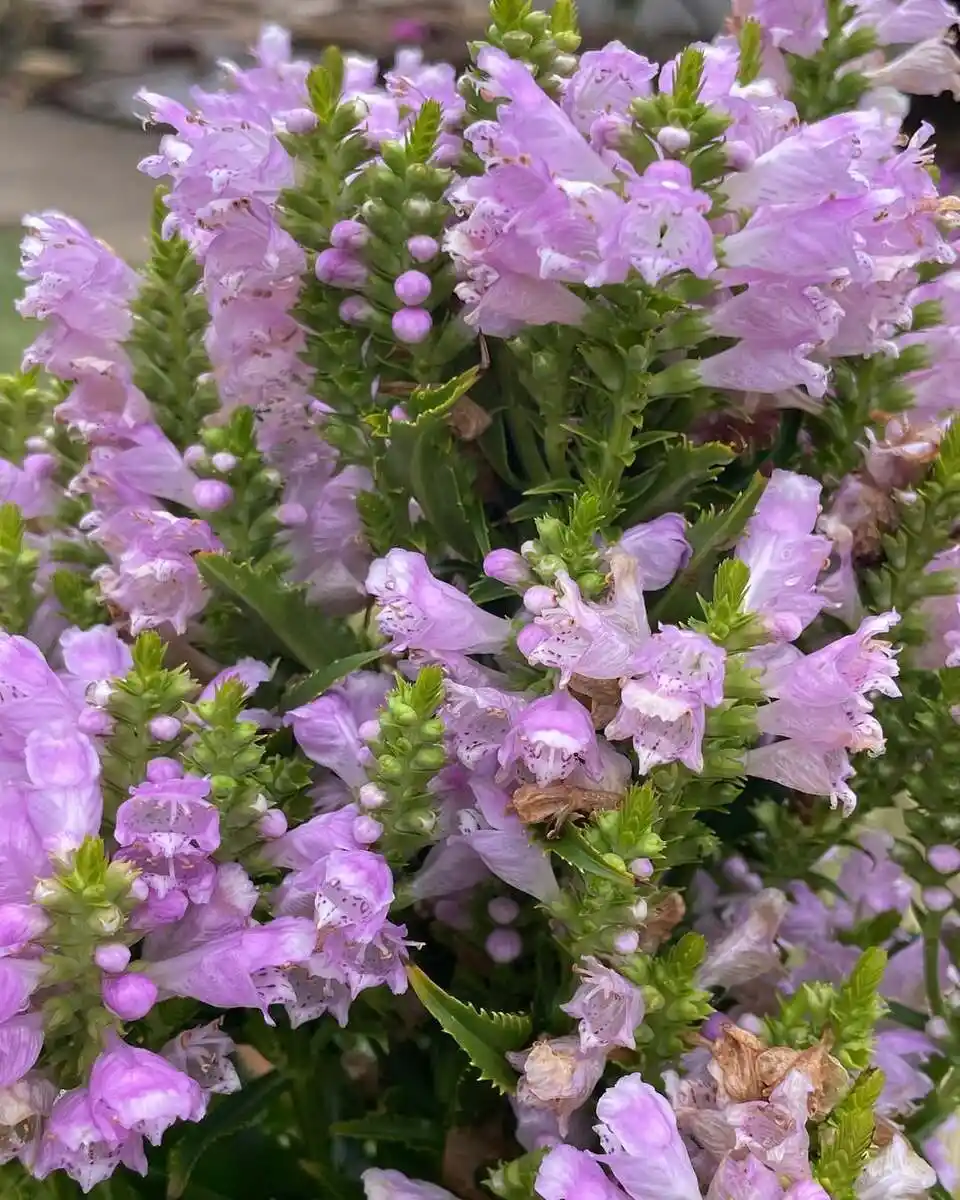
Identification & Character: Square stems with neat, vertical spikes of snapdragon-like flowers; blooms line up like disciplined soldiers (hence the name).
USDA Zones: 3–9. Sun: Full sun. Soil: Moist, well-drained; tolerates average.
Bloom Season: Late summer into fall. Colors: Pink, white. Type: Herbaceous perennial (can spread). Scientific: Physostegia virginiana.
I corral it with edging or plant it where it can run (behind a bench, along a fence). In late summer, when nectar starts tightening, it comes through for the hummingbirds.
Hollyhock (Alcea rosea)
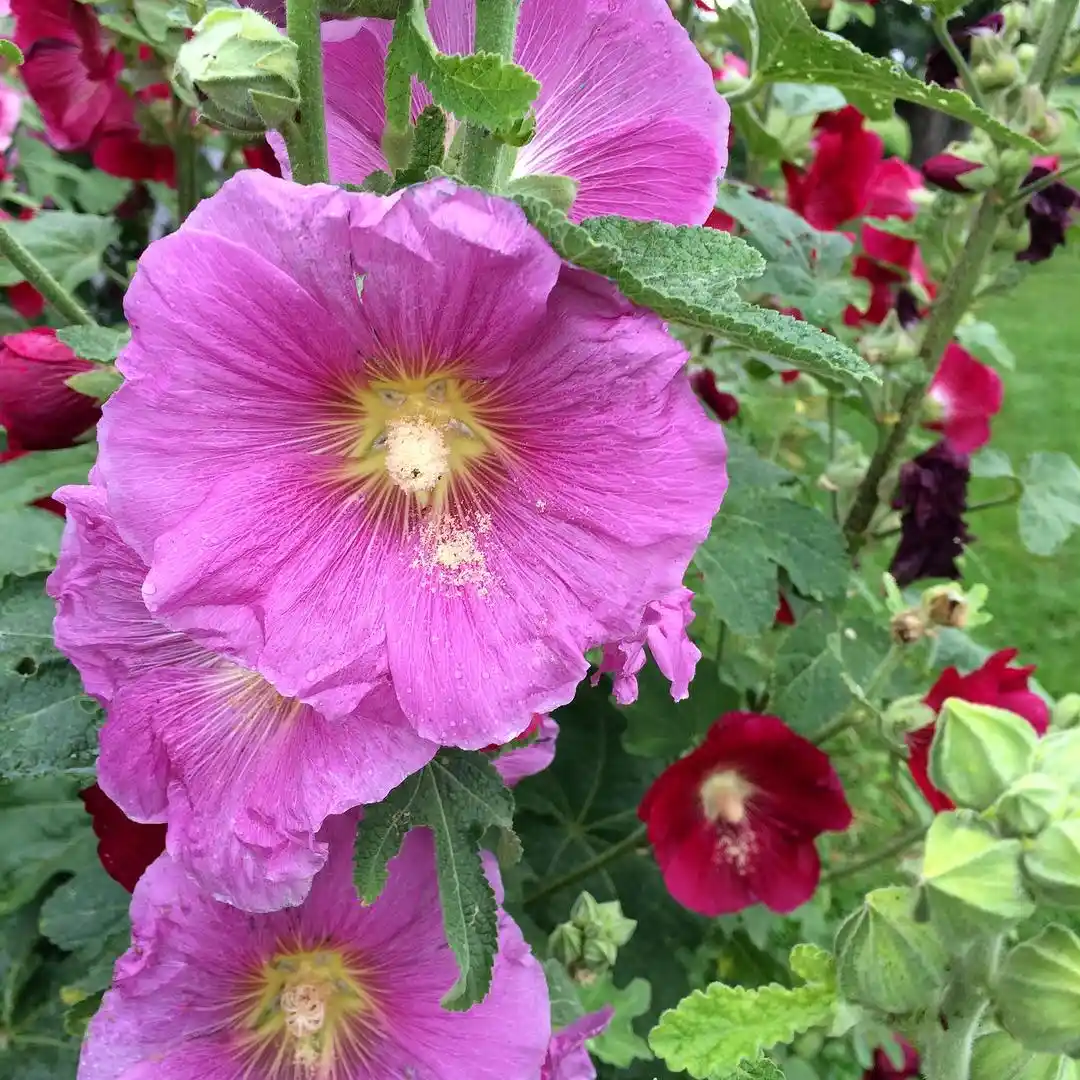
Identification & Character: Tall, nostalgic spires stacked with saucer blooms; they read as a vertical wall of color.
USDA Zones: 3–8 (often short-lived but self-seeds). Sun: Full. Soil: Average, well-drained.
Bloom Season: Summer. Colors: Every cottage hue from butter yellow to deep burgundy. Type: Short-lived perennial/biennial. Scientific: Alcea rosea.
For the old-world look, plant hollyhocks against sheds or sunny walls. Rust can be pesky; give them air flow and remove affected foliage.
Canna Lily (Canna indica and hybrids)
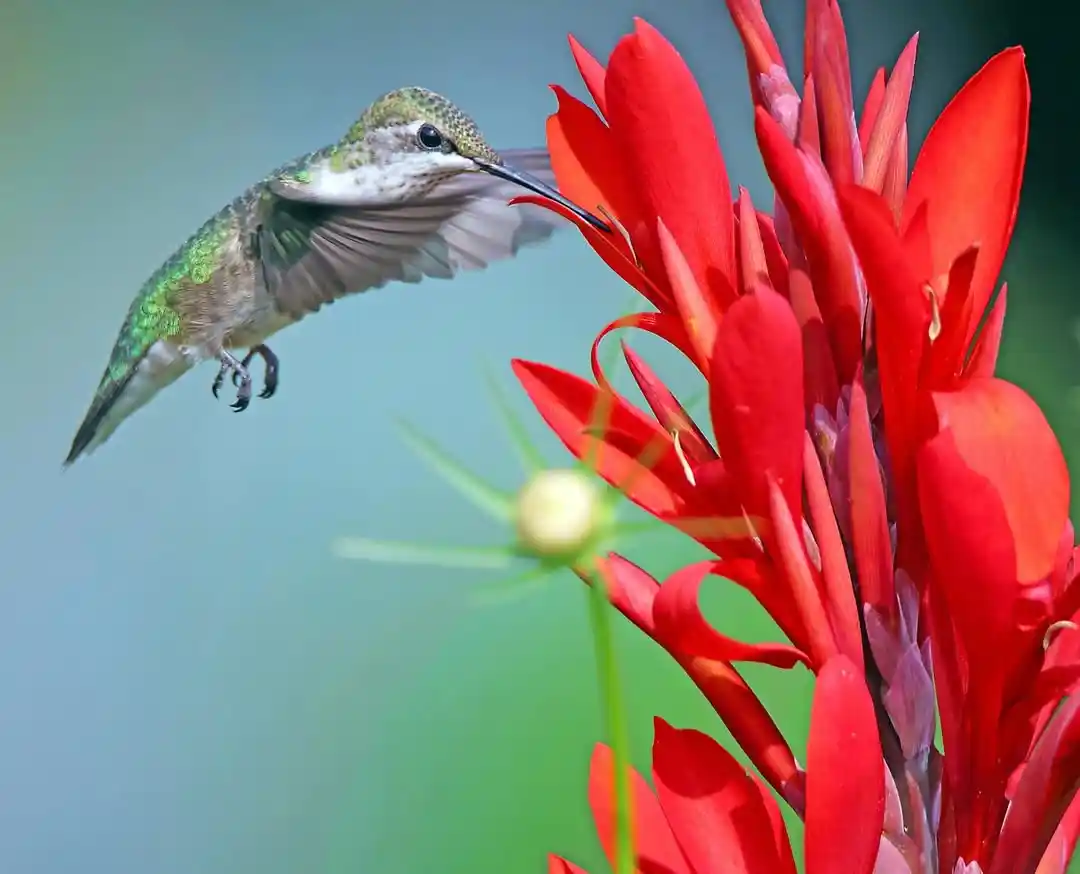
Identification & Character: Big tropical leaves with flaming flower spikes—like instant vacation in your yard.
USDA Zones: Hardy 8–11 (lift rhizomes where colder). Sun: Full. Soil: Rich, moist.
Bloom Season: Summer to frost. Colors: Red, orange, yellow, pink, bicolors. Type: Rhizomatous perennial. Scientific: Canna spp.
In cool climates, I treat cannas like treasured summer accents and store rhizomes after frost. Hummingbirds adore the bold, tubular flowers—especially in saturated reds.
Catmint (Nepeta)
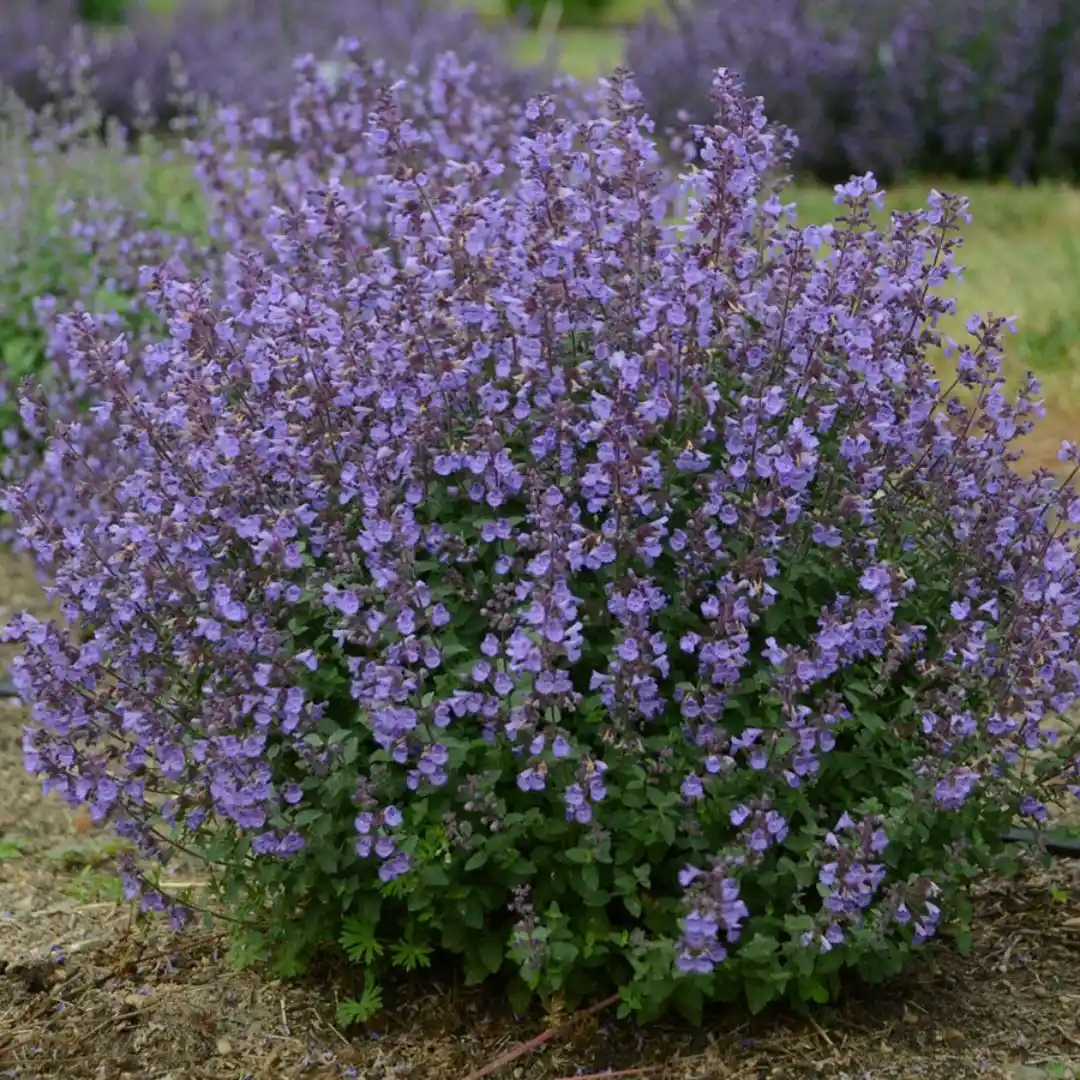
Identification & Character: Cushions of gray-green leaves and frothy lavender-blue spires that last and last (and last).
USDA Zones: 4–8. Sun: Full sun (tolerates some shade). Soil: Well-drained; drought-tolerant once established.
Bloom Season: Late spring into summer (often reblooms if sheared). Colors: Lavender-blue, with pink/white cultivars. Type: Herbaceous perennial. Scientific: Nepeta (incl. N. cataria, N. × faassenii).
I use catmint as a soft, perfumed skirt for taller nectar plants like penstemon and salvia. Bonus: low maintenance with a long hummingbird season.
Garden Phlox (Phlox paniculata)
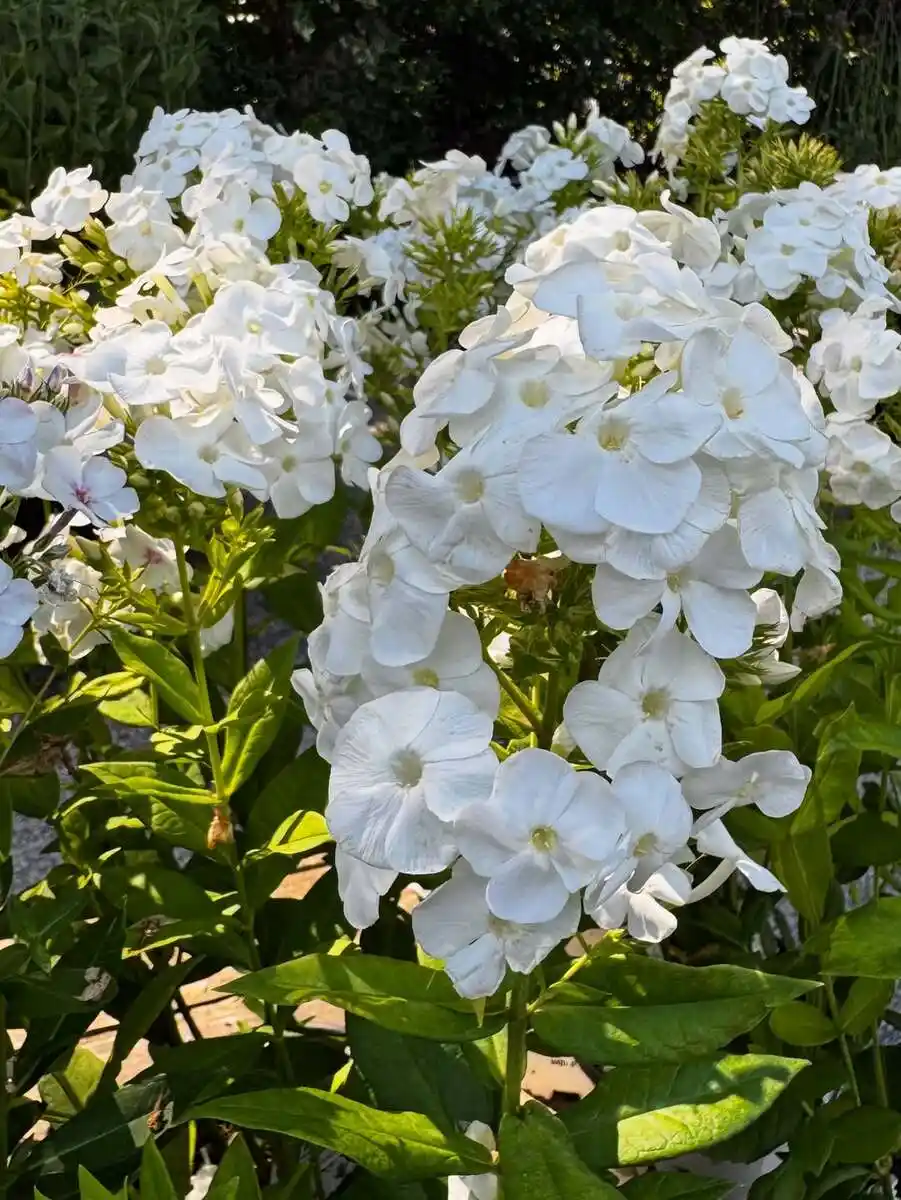
Identification & Character: Tall, scented domes of flowers—think classic July garden.
USDA Zones: 4–8. Sun: Full to part sun. Soil: Moist, fertile, well-drained.
Bloom Season: Midsummer to late summer. Colors: White, pink, coral, magenta, lavender, bi-colors. Type: Herbaceous perennial. Scientific: Phlox paniculata.
I thin stems early for airflow (powdery mildew prevention) and combine with salvias and daylilies for a hummingbird-heavy mid-summer trio.
Lungwort (Pulmonaria)
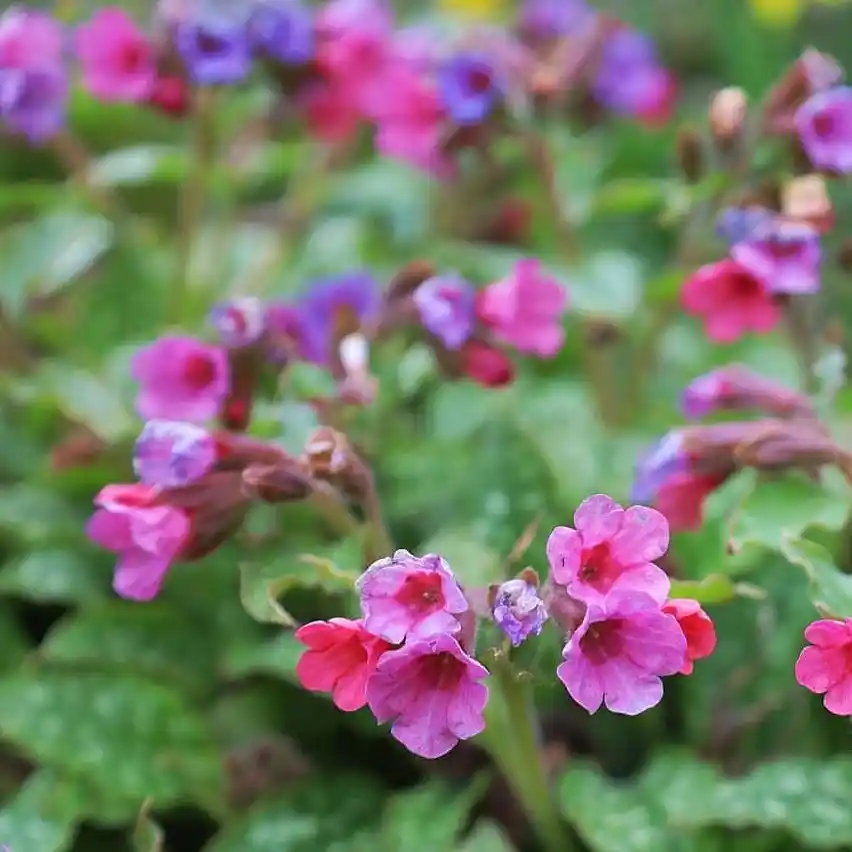
Identification & Character: Speckled leaves and early spring flowers that shift from pink to blue—yes, color-changing blooms.
USDA Zones: 3–8. Sun: Shade to part shade. Soil: Moist, humus-rich.
Bloom Season: Early spring. Colors: Pink to blue; also whites. Type: Herbaceous perennial. Scientific: Pulmonaria.
Lungwort is one of my favorite early nectar sources in cool, shaded beds. I pair it with hellebores and ferns for a woodland palette hummingbirds can’t resist.
Blazing Star (Liatris spicata)
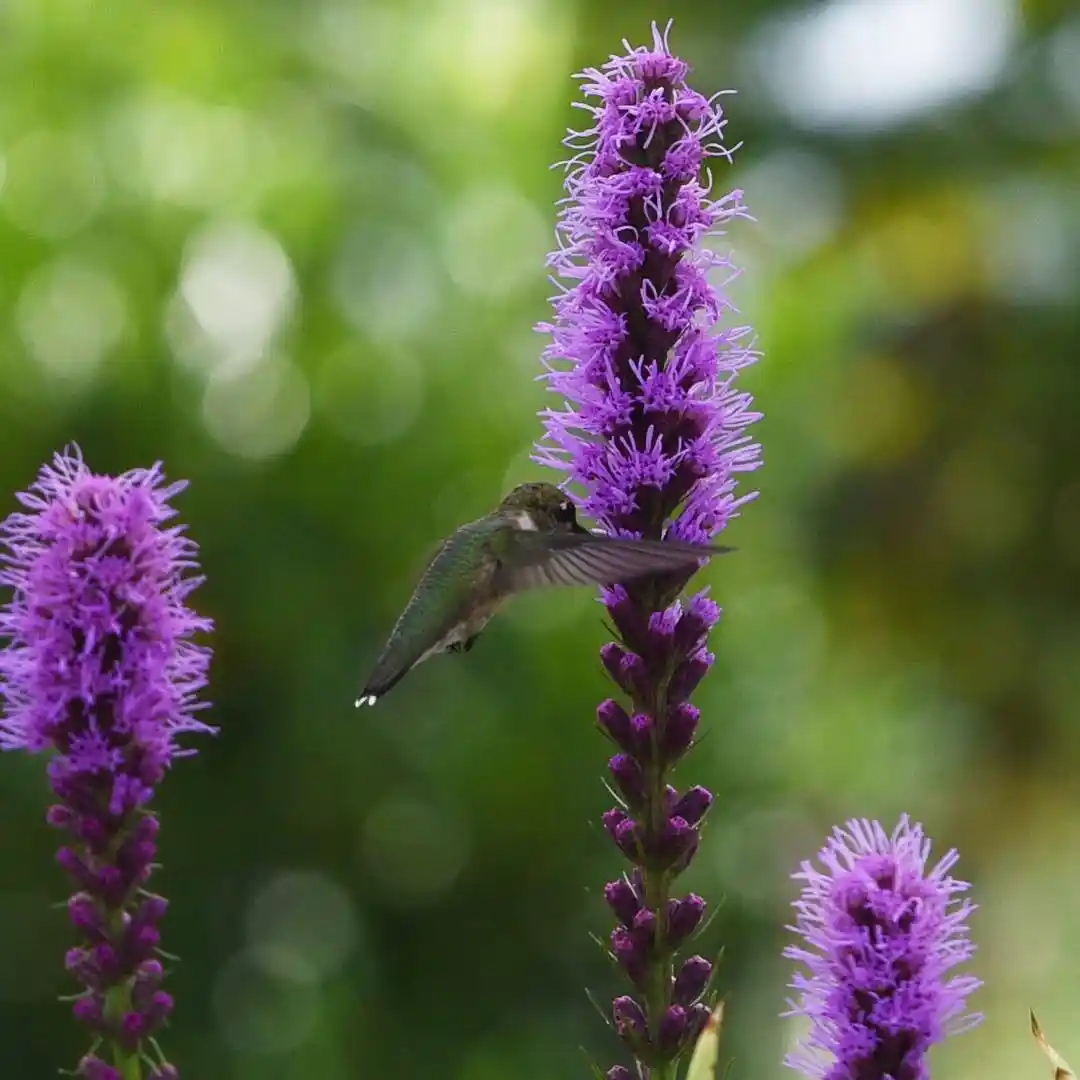
Identification & Character: Bottlebrush plumes that bloom from top to bottom—counter-intuitive and very cool.
USDA Zones: 3–8. Sun: Full. Soil: Average to dry; hates soggy roots.
Bloom Season: Mid to late summer. Colors: Purple/violet, white cultivars. Type: Cormous perennial. Scientific: Liatris.
Butterflies crowd it, and hummingbirds pop in between—especially if I mass five or more in a sunny block. Loves open spaces and prairie-style designs.
Anise Hyssop (Agastache foeniculum)
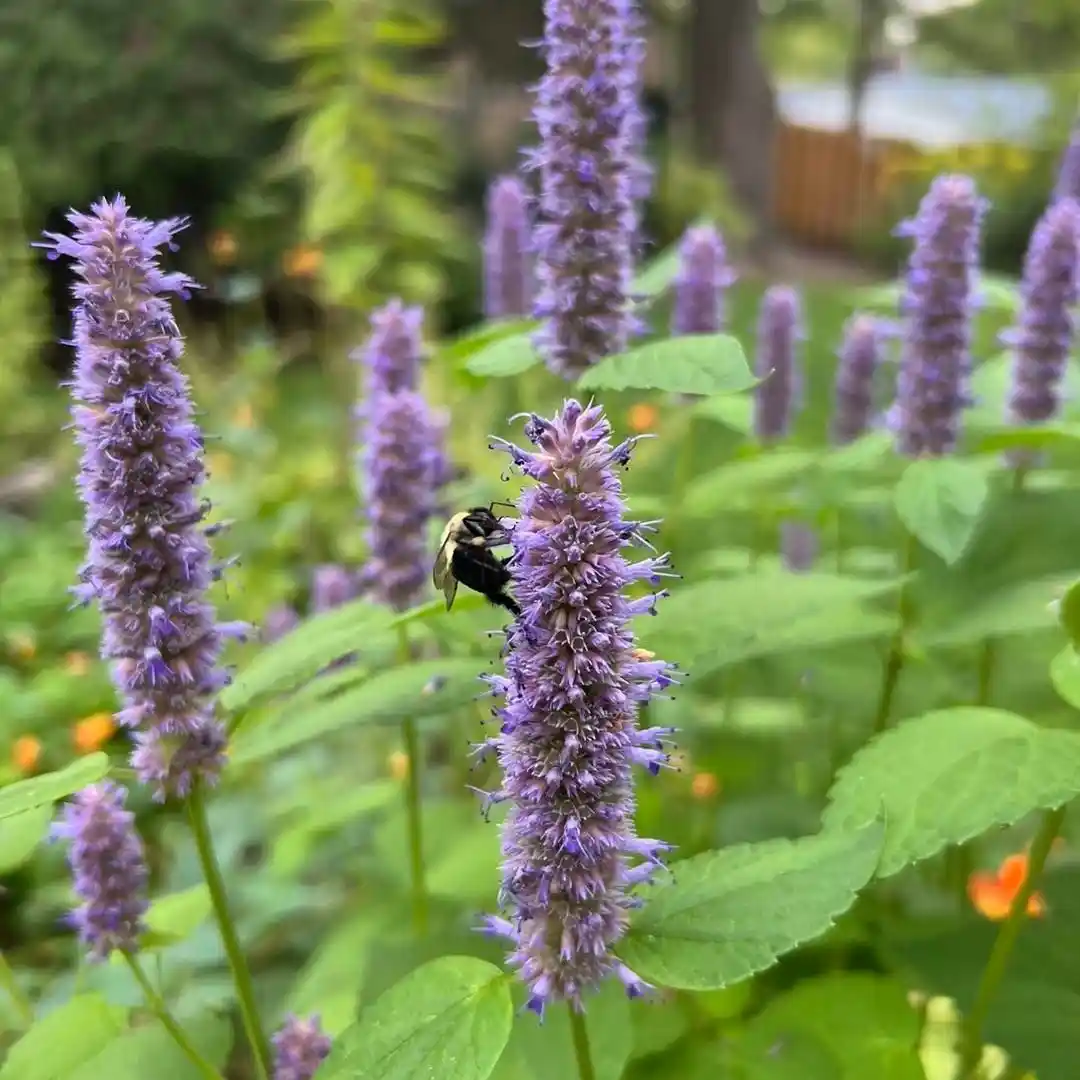
Identification & Character: Licorice-anise scented leaves with nectar-rich spikes.
USDA Zones: 4–9 (approx.). Sun: Full. Soil: Well-drained, drought-lean.
Bloom Season: Summer to fall. Colors: Lavender-purple most common. Type: Herbaceous perennial. Scientific: Agastache foeniculum.
If you’ve got rabbits, good news: they usually pass this by. I let a few seed around because the effect is meadow-soft and the hummingbirds approve.
Cape Fuchsia (Phygelius)
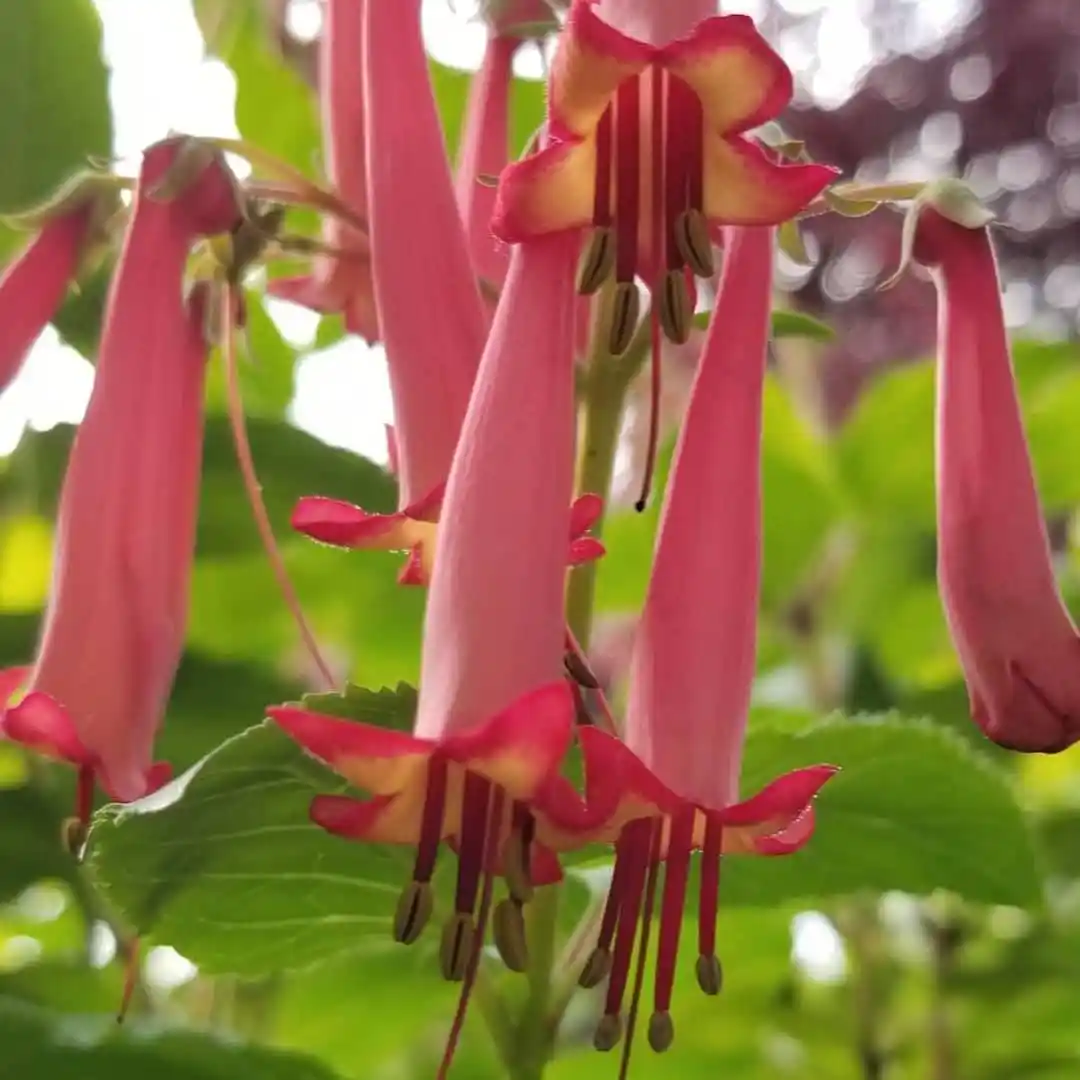
Identification & Character: Clusters of flared, tubular bells—like a smaller, tidier cousin of trumpet vine.
USDA Zones: Often 7–10 (colder with protection). Sun: Full to part sun. Soil: Average, well-drained.
Bloom Season: Summer into fall. Colors: Salmon, coral, pink, yellow, white. Type: Subshrubby perennial. Scientific: Phygelius.
Where winters are mild, it’s nearly evergreen and feeds hummingbirds late in the season when other nectar wanes.
Snapdragon (Antirrhinum)
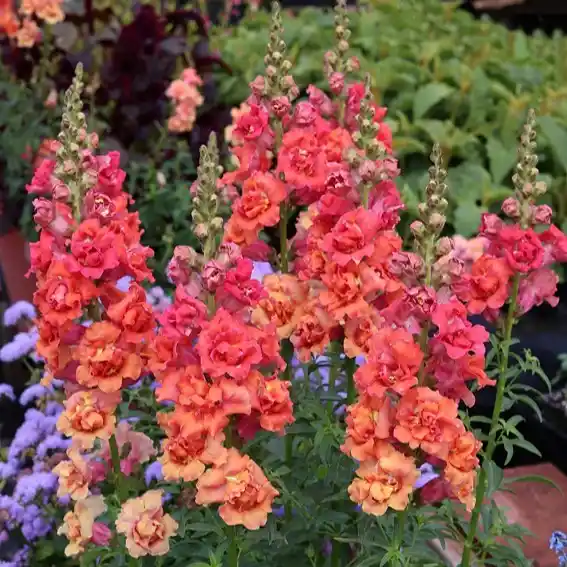
Identification & Character: Spires with snap-to-open blooms (press the “mouth” and it smiles—childhood nostalgia unlocked).
USDA Zones: 7–11 (tender elsewhere). Sun: Full to part sun. Soil: Average, well-drained.
Bloom Season: Spring to fall in cool-summer climates. Colors: Basically all the candy colors. Type: Short-lived perennial (often grown as annual). Scientific: Antirrhinum.
I like snapdragons in a cutting patch near the kitchen—easy to snip, and the hummingbirds will meet you there. In warmer regions, they can behave as a true perennial and join your roster of perennial flowers that attract hummingbirds.
Trumpet Honeysuckle (Lonicera sempervirens)
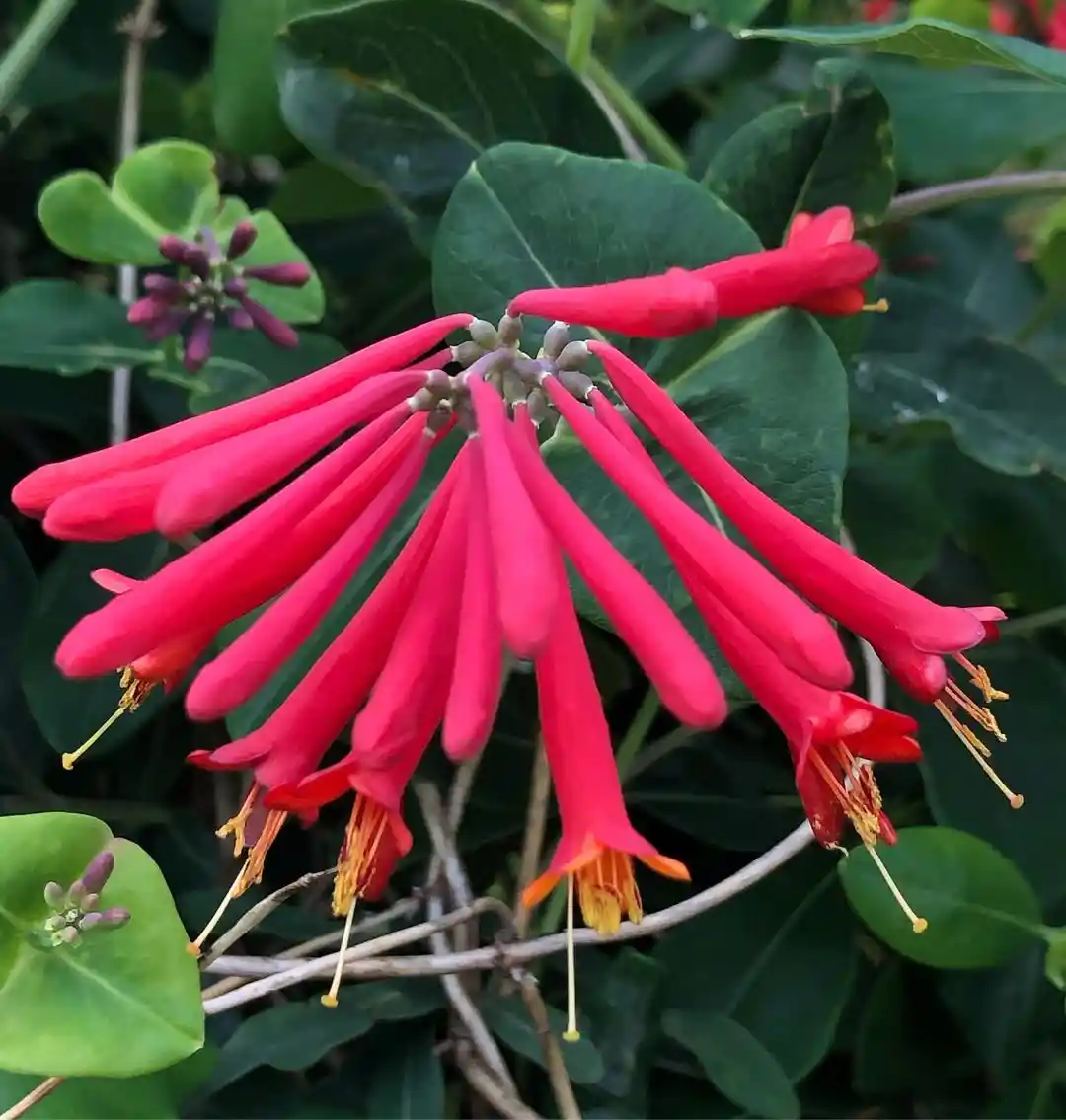
Identification & Character: Coral-red tubes in clusters against glossy leaves; less rampant than some honeysuckles.
USDA Zones: Commonly 4–9. Sun: Full to part sun. Soil: Average, well-drained.
Bloom Season: Late spring through summer, some fall. Colors: Coral, red, yellow selections. Type: Woody vine. Scientific: L. sempervirens.
If you want a clean-lined trellis with reliable nectar, this is the vine. Train it early, tie it neatly, and thank me later when hummingbirds treat it like home base.
How I stack bloom time so hummingbirds never miss a meal
- Spring kick-off: Lungwort, columbine, foxglove, early salvias.
- Summer main course: Bee balm, daylily, garden phlox, penstemon, delphinium, catmint.
- Late-season dessert: Agastache, cape fuchsia, obedient plant, trumpet vine.
This follow-the-flowers rhythm nails the essentials: go heavy on tubular blooms, lean bold on reds, and choose species that suit your zones and site so the plants actually bloom (and feed).
Design notes (from my slightly perfectionist brain)
- Color blocking > random polka dots. Group 3–7 of the same plant so hummingbirds “work” the patch efficiently (you’ll get longer visits).
- Layer like a stage: low (catmint, heuchera), middle (bee balm, penstemon), tall (salvia, delphinium), and a vertical nectar anchor (trumpet vine or trumpet honeysuckle) behind.
- Think shade, too: hosta + bleeding heart keep nectar going where sun-lovers won’t play.
- Water + perches: a light mister or dripper and a few flat stones or twiggy branches—suddenly you’ve got a proper hummingbird lounge.
- Maintenance rhythm: deadhead for repeat, cut back hard bloomers once, and feed modestly. Avoid super rich soils for dry-garden species (penstemon, agastache) or they get floppy.
Quick reference: what to prioritize for hummingbirds
- Tubular blooms & bold colors (red especially)—fit, visibility, and nectar volume all favor hummingbirds.
- Native or region-appropriate plants—easier care, better timed to local birds.
- Staggered bloom seasons—so your yard is always “open.”
Why these exact plants made the cut
The standouts here emphasize overlapping, reliable options—from bee balm, salvia, and penstemon to cardinal flower and trumpet vine—and collectively surface 15–25 of the most hummingbird-friendly perennials gardeners actually succeed with. The simple but powerful idea: match plants to your zone and sun/soil, then keep the nectar line open from spring to frost.
FAQ: perennial flowers that attract hummingbirds (answers from the dirt)
1) What makes a flower irresistible to hummingbirds?
Tubular shape (perfect for their long bills), bold colors (reds are visual magnets), and reliable nectar production. That’s why so many perennial flowers that attract hummingbirds are trumpet-shaped or spurred and show up in fire-engine reds and hot corals.
2) How many of these plants do I really need?
For a meaningful “wow,” plant in drifts: 3–5 of one species is a start; 7–9 is magic. Hummingbirds circle and refuel longer when they can work a patch, especially with hummingbird-friendly perennials like bee balm and salvia.
3) Can I build an all-shade hummingbird bed?
Yes—hosta, bleeding heart, and a few shade-tolerant salvias give you flowers in lower light. It’s quieter than a full-sun bed, but still a real feeder station for birds.
4) I’m in a hot, dry climate—what thrives?
Penstemon, agastache, and catmint are stars in heat and lean soils. They’re the backbone of many southwestern perennials for hummingbirds, needing good drainage and full sun.
5) What’s one mistake people make with trumpet vine?
Letting it roam. It’s wonderfully effective among perennial flowers that attract hummingbirds, but assign it to a sturdy support and prune hard after bloom so it doesn’t take over.
6) Do I still need feeders if I plant all these?
You don’t need them, but a clean, dye-free nectar feeder supplements natural forage during weather swings. The plants are the foundation; the feeder is a reliable back-up (and a great way to watch birds up close). A simple mister adds bonus joy—hummers love the fine spray.
7) How do I make blooms last longer?
Deadhead and shear lightly after the first flush on rebloomers (salvia, catmint). Keep moisture steady for plants that prefer it (hosta, phlox), and don’t overwater dry-garden species (penstemon, agastache).
8) Which reds give me instant results?
Cardinal flower, trumpet honeysuckle, red bee balm, and many daylilies. Pair them with purple or blue salvias for pop and continuous nectar.
9) What about early spring nectar when birds first show up?
Columbine and lungwort are fantastic early bloomers. Add Jacob’s ladder for extra early color in part shade—your yard becomes the first reliable stop.
10) Can I grow these in containers?
Yes—fuchsia, salvia, compact agastache, and even small penstemons shine in pots. Use a light, well-draining mix and feed lightly so you get blooms, not just leaves.
11) Are there kid- or pet-safe considerations?
Some plants (like foxglove) are toxic if ingested. Place them thoughtfully and teach little hands not to nibble. Always research the specific species you bring home.
12) How do I plan for constant nectar?
Make a simple three-season map: early (columbine, lungwort), mid (bee balm, daylily, phlox, salvia), late (agastache, obedient plant, cape fuchsia, trumpet vine). Then plant in roomy, repeating groups.
13) I have heavy clay—am I doomed?
Not at all. Amend with compost and coarse grit where needed. Choose tougher hummingbird perennials like daylily and bee balm while you gradually improve drainage.
14) My yard is tiny. What’s the minimum?
One vertical (trumpet honeysuckle on a trellis), one long bloomer (salvia), one shade-tolerant option if needed (heuchera), and one container by the door (fuchsia). You’ll still see daily traffic.
15) How many times should I use the phrase “perennial flowers that attract hummingbirds” in my garden journal?
As many as it takes to remember your goal: a yard that feeds and dazzles. Jokes aside, keep notes—what bloomed when, who visited, and what you’ll add next season to keep the nectar parade going.
Final nudge
Plant with intention: tubular shapes, bold color, and a calendar of blooms. Mix sun-lovers with shade allies, and use vines to build a vertical nectar layer. The result isn’t just pretty—it’s alive. I’ve watched hummingbirds patrol a well-planned border like devoted regulars, returning at the same times each day. That’s the quiet magic of perennial flowers that attract hummingbirds—they turn your yard into a favorite stop on a tiny traveler’s daily commute. And you get front-row seats, coffee in hand.

